Impact of ERP on Performance of Accountants: A Case Study of Westpac Bank
VerifiedAdded on 2023/04/22
|21
|5547
|91
AI Summary
This research aims to address the impact of ERP on the performance of accountants, a case study of Westpac bank. It recommends different strategies for effectively implying the ERP software to improve the organization performance.
Contribute Materials
Your contribution can guide someone’s learning journey. Share your
documents today.
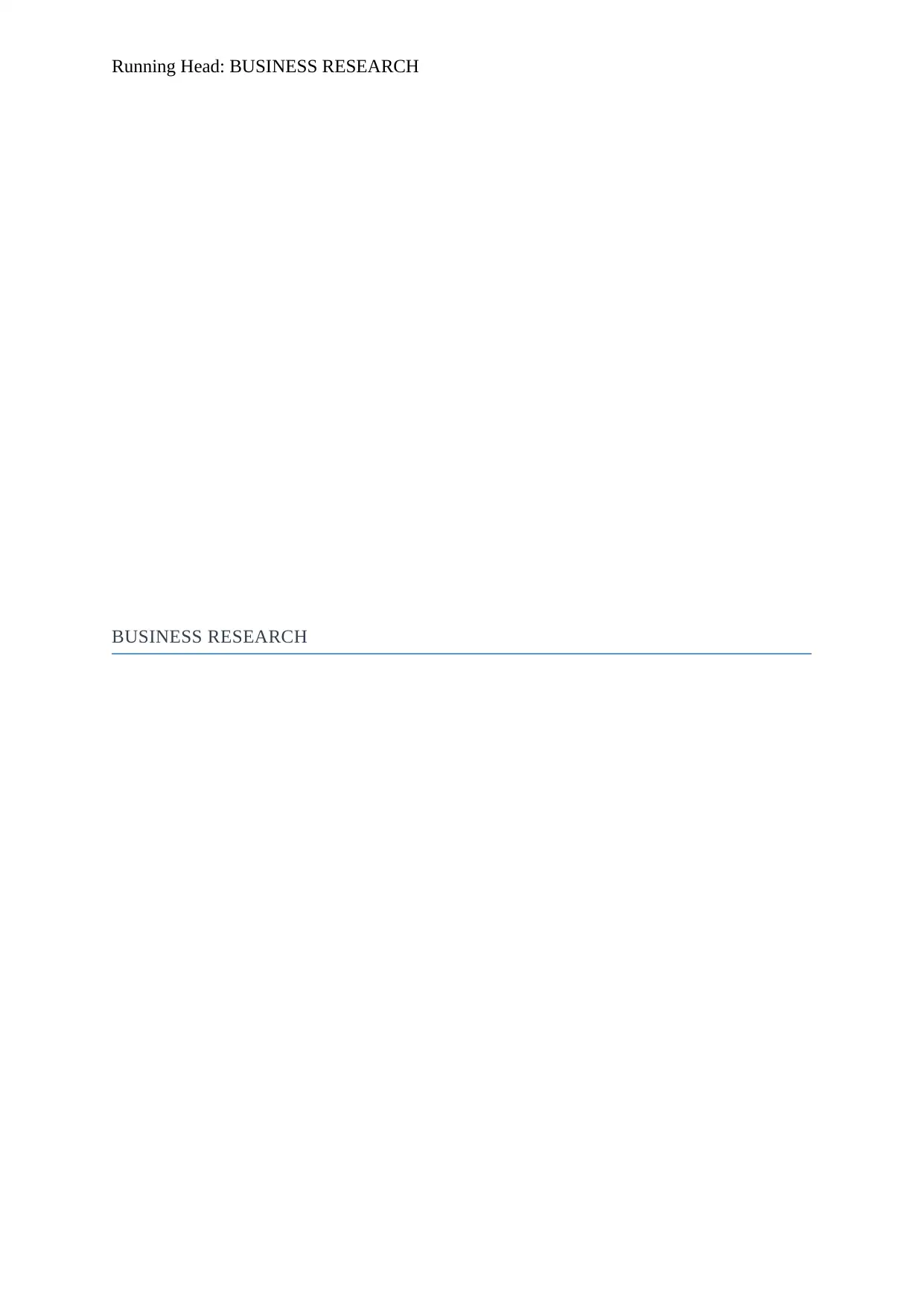
Running Head: BUSINESS RESEARCH
BUSINESS RESEARCH
BUSINESS RESEARCH
Secure Best Marks with AI Grader
Need help grading? Try our AI Grader for instant feedback on your assignments.
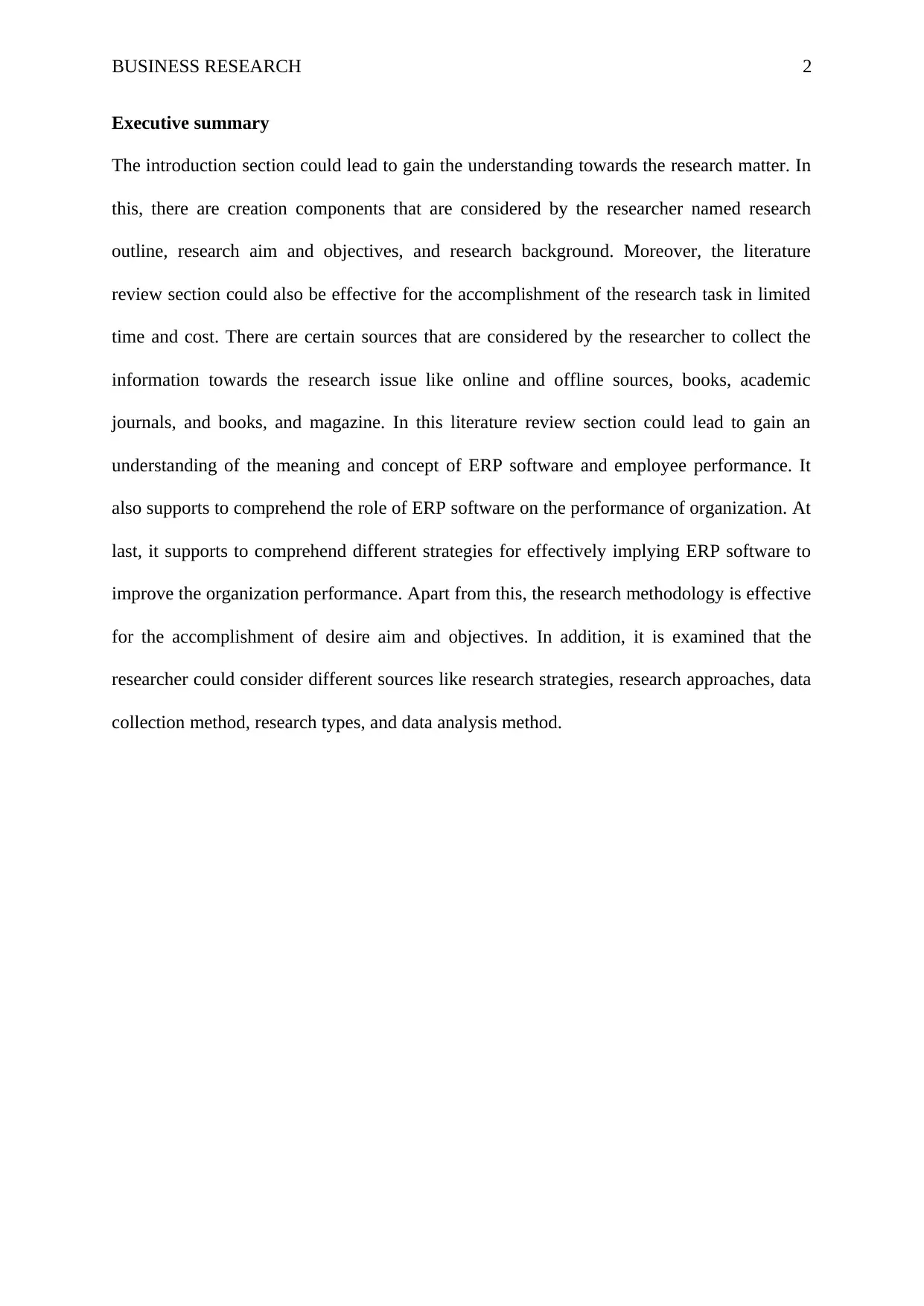
BUSINESS RESEARCH 2
Executive summary
The introduction section could lead to gain the understanding towards the research matter. In
this, there are creation components that are considered by the researcher named research
outline, research aim and objectives, and research background. Moreover, the literature
review section could also be effective for the accomplishment of the research task in limited
time and cost. There are certain sources that are considered by the researcher to collect the
information towards the research issue like online and offline sources, books, academic
journals, and books, and magazine. In this literature review section could lead to gain an
understanding of the meaning and concept of ERP software and employee performance. It
also supports to comprehend the role of ERP software on the performance of organization. At
last, it supports to comprehend different strategies for effectively implying ERP software to
improve the organization performance. Apart from this, the research methodology is effective
for the accomplishment of desire aim and objectives. In addition, it is examined that the
researcher could consider different sources like research strategies, research approaches, data
collection method, research types, and data analysis method.
Executive summary
The introduction section could lead to gain the understanding towards the research matter. In
this, there are creation components that are considered by the researcher named research
outline, research aim and objectives, and research background. Moreover, the literature
review section could also be effective for the accomplishment of the research task in limited
time and cost. There are certain sources that are considered by the researcher to collect the
information towards the research issue like online and offline sources, books, academic
journals, and books, and magazine. In this literature review section could lead to gain an
understanding of the meaning and concept of ERP software and employee performance. It
also supports to comprehend the role of ERP software on the performance of organization. At
last, it supports to comprehend different strategies for effectively implying ERP software to
improve the organization performance. Apart from this, the research methodology is effective
for the accomplishment of desire aim and objectives. In addition, it is examined that the
researcher could consider different sources like research strategies, research approaches, data
collection method, research types, and data analysis method.
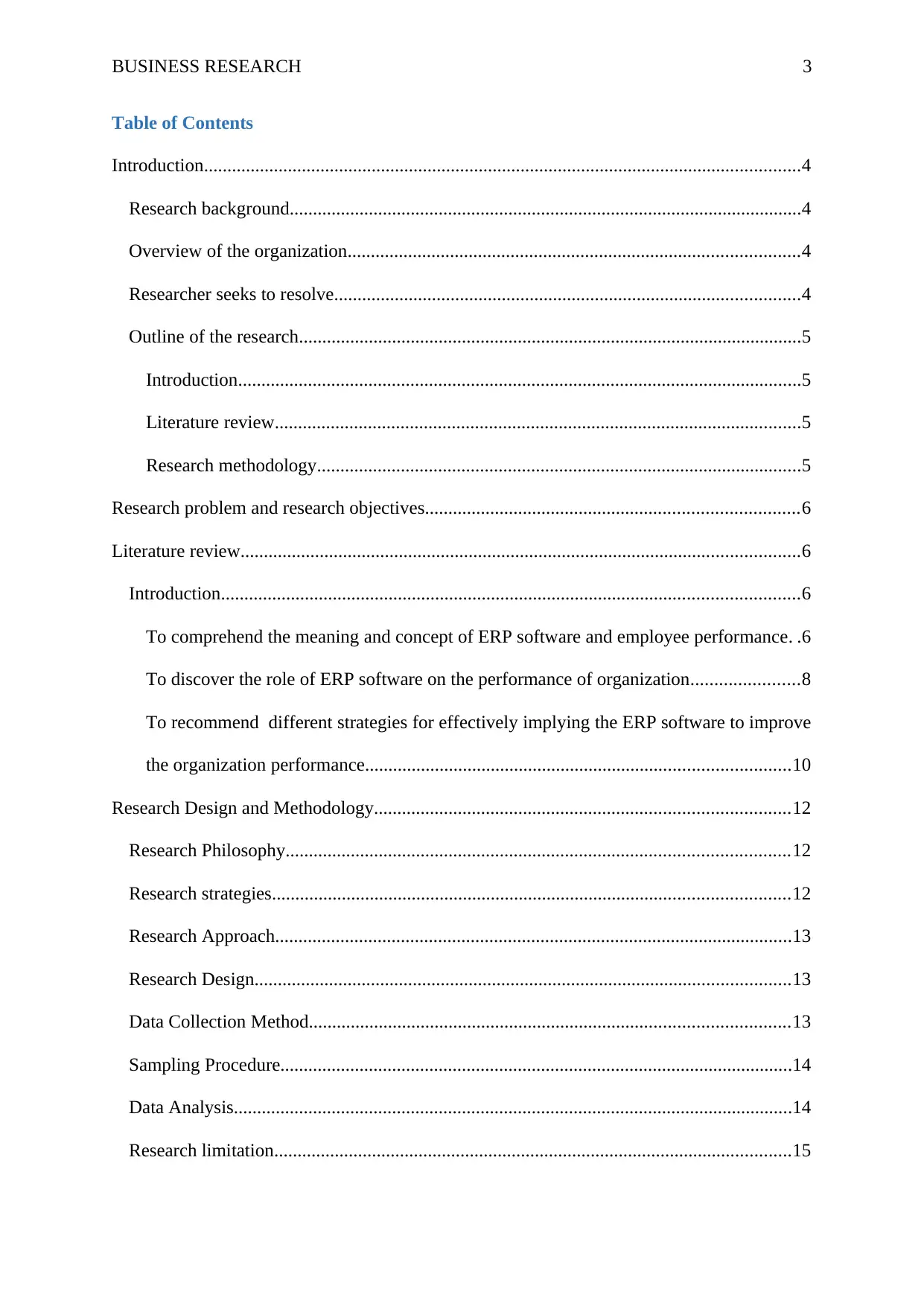
BUSINESS RESEARCH 3
Table of Contents
Introduction................................................................................................................................4
Research background..............................................................................................................4
Overview of the organization.................................................................................................4
Researcher seeks to resolve....................................................................................................4
Outline of the research............................................................................................................5
Introduction.........................................................................................................................5
Literature review.................................................................................................................5
Research methodology........................................................................................................5
Research problem and research objectives................................................................................6
Literature review........................................................................................................................6
Introduction............................................................................................................................6
To comprehend the meaning and concept of ERP software and employee performance. .6
To discover the role of ERP software on the performance of organization.......................8
To recommend different strategies for effectively implying the ERP software to improve
the organization performance...........................................................................................10
Research Design and Methodology.........................................................................................12
Research Philosophy............................................................................................................12
Research strategies...............................................................................................................12
Research Approach...............................................................................................................13
Research Design...................................................................................................................13
Data Collection Method.......................................................................................................13
Sampling Procedure..............................................................................................................14
Data Analysis........................................................................................................................14
Research limitation...............................................................................................................15
Table of Contents
Introduction................................................................................................................................4
Research background..............................................................................................................4
Overview of the organization.................................................................................................4
Researcher seeks to resolve....................................................................................................4
Outline of the research............................................................................................................5
Introduction.........................................................................................................................5
Literature review.................................................................................................................5
Research methodology........................................................................................................5
Research problem and research objectives................................................................................6
Literature review........................................................................................................................6
Introduction............................................................................................................................6
To comprehend the meaning and concept of ERP software and employee performance. .6
To discover the role of ERP software on the performance of organization.......................8
To recommend different strategies for effectively implying the ERP software to improve
the organization performance...........................................................................................10
Research Design and Methodology.........................................................................................12
Research Philosophy............................................................................................................12
Research strategies...............................................................................................................12
Research Approach...............................................................................................................13
Research Design...................................................................................................................13
Data Collection Method.......................................................................................................13
Sampling Procedure..............................................................................................................14
Data Analysis........................................................................................................................14
Research limitation...............................................................................................................15

BUSINESS RESEARCH 4
Ethical considerations...........................................................................................................15
Refrences..................................................................................................................................16
Ethical considerations...........................................................................................................15
Refrences..................................................................................................................................16
Secure Best Marks with AI Grader
Need help grading? Try our AI Grader for instant feedback on your assignments.
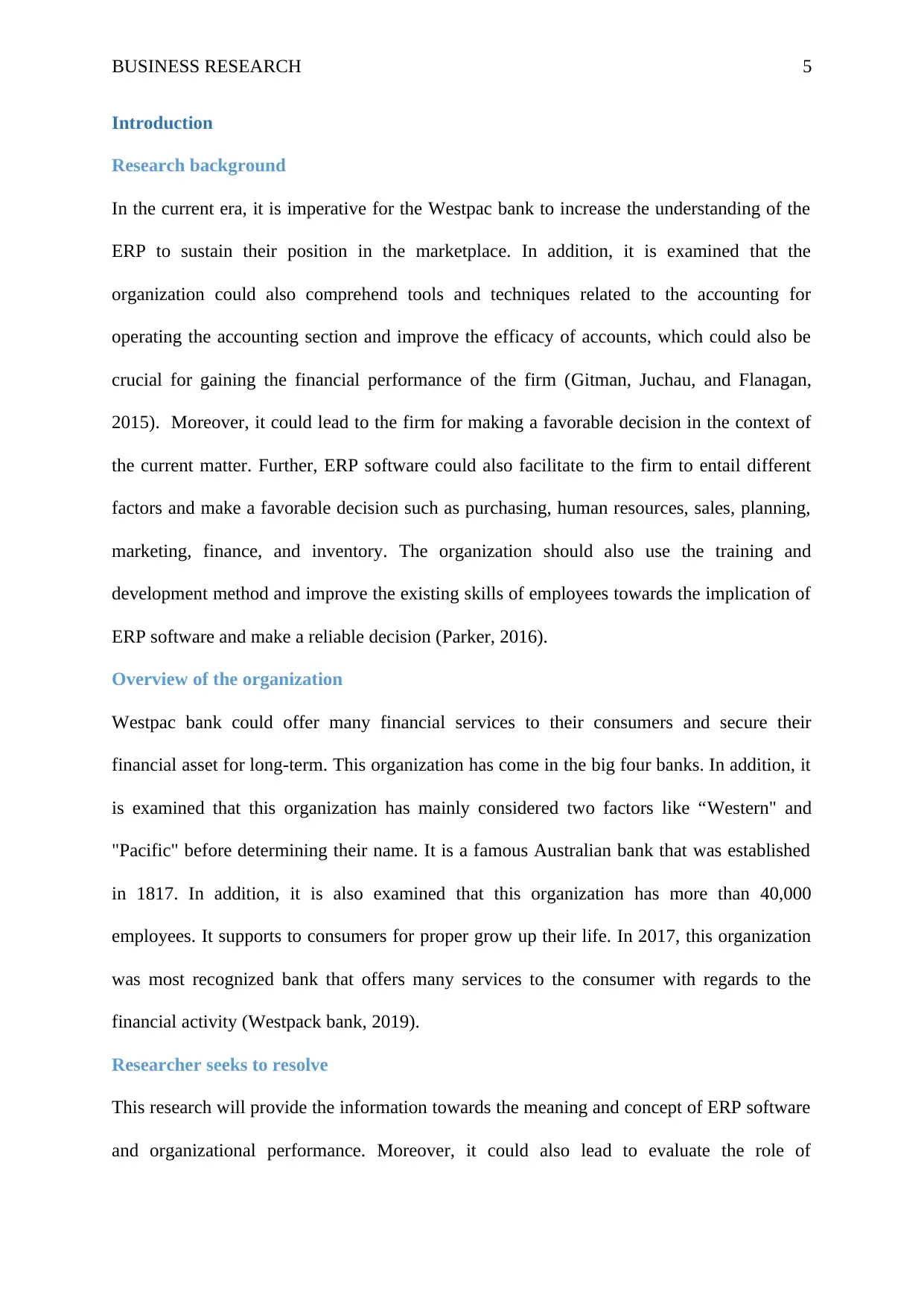
BUSINESS RESEARCH 5
Introduction
Research background
In the current era, it is imperative for the Westpac bank to increase the understanding of the
ERP to sustain their position in the marketplace. In addition, it is examined that the
organization could also comprehend tools and techniques related to the accounting for
operating the accounting section and improve the efficacy of accounts, which could also be
crucial for gaining the financial performance of the firm (Gitman, Juchau, and Flanagan,
2015). Moreover, it could lead to the firm for making a favorable decision in the context of
the current matter. Further, ERP software could also facilitate to the firm to entail different
factors and make a favorable decision such as purchasing, human resources, sales, planning,
marketing, finance, and inventory. The organization should also use the training and
development method and improve the existing skills of employees towards the implication of
ERP software and make a reliable decision (Parker, 2016).
Overview of the organization
Westpac bank could offer many financial services to their consumers and secure their
financial asset for long-term. This organization has come in the big four banks. In addition, it
is examined that this organization has mainly considered two factors like “Western" and
"Pacific" before determining their name. It is a famous Australian bank that was established
in 1817. In addition, it is also examined that this organization has more than 40,000
employees. It supports to consumers for proper grow up their life. In 2017, this organization
was most recognized bank that offers many services to the consumer with regards to the
financial activity (Westpack bank, 2019).
Researcher seeks to resolve
This research will provide the information towards the meaning and concept of ERP software
and organizational performance. Moreover, it could also lead to evaluate the role of
Introduction
Research background
In the current era, it is imperative for the Westpac bank to increase the understanding of the
ERP to sustain their position in the marketplace. In addition, it is examined that the
organization could also comprehend tools and techniques related to the accounting for
operating the accounting section and improve the efficacy of accounts, which could also be
crucial for gaining the financial performance of the firm (Gitman, Juchau, and Flanagan,
2015). Moreover, it could lead to the firm for making a favorable decision in the context of
the current matter. Further, ERP software could also facilitate to the firm to entail different
factors and make a favorable decision such as purchasing, human resources, sales, planning,
marketing, finance, and inventory. The organization should also use the training and
development method and improve the existing skills of employees towards the implication of
ERP software and make a reliable decision (Parker, 2016).
Overview of the organization
Westpac bank could offer many financial services to their consumers and secure their
financial asset for long-term. This organization has come in the big four banks. In addition, it
is examined that this organization has mainly considered two factors like “Western" and
"Pacific" before determining their name. It is a famous Australian bank that was established
in 1817. In addition, it is also examined that this organization has more than 40,000
employees. It supports to consumers for proper grow up their life. In 2017, this organization
was most recognized bank that offers many services to the consumer with regards to the
financial activity (Westpack bank, 2019).
Researcher seeks to resolve
This research will provide the information towards the meaning and concept of ERP software
and organizational performance. Moreover, it could also lead to evaluate the role of
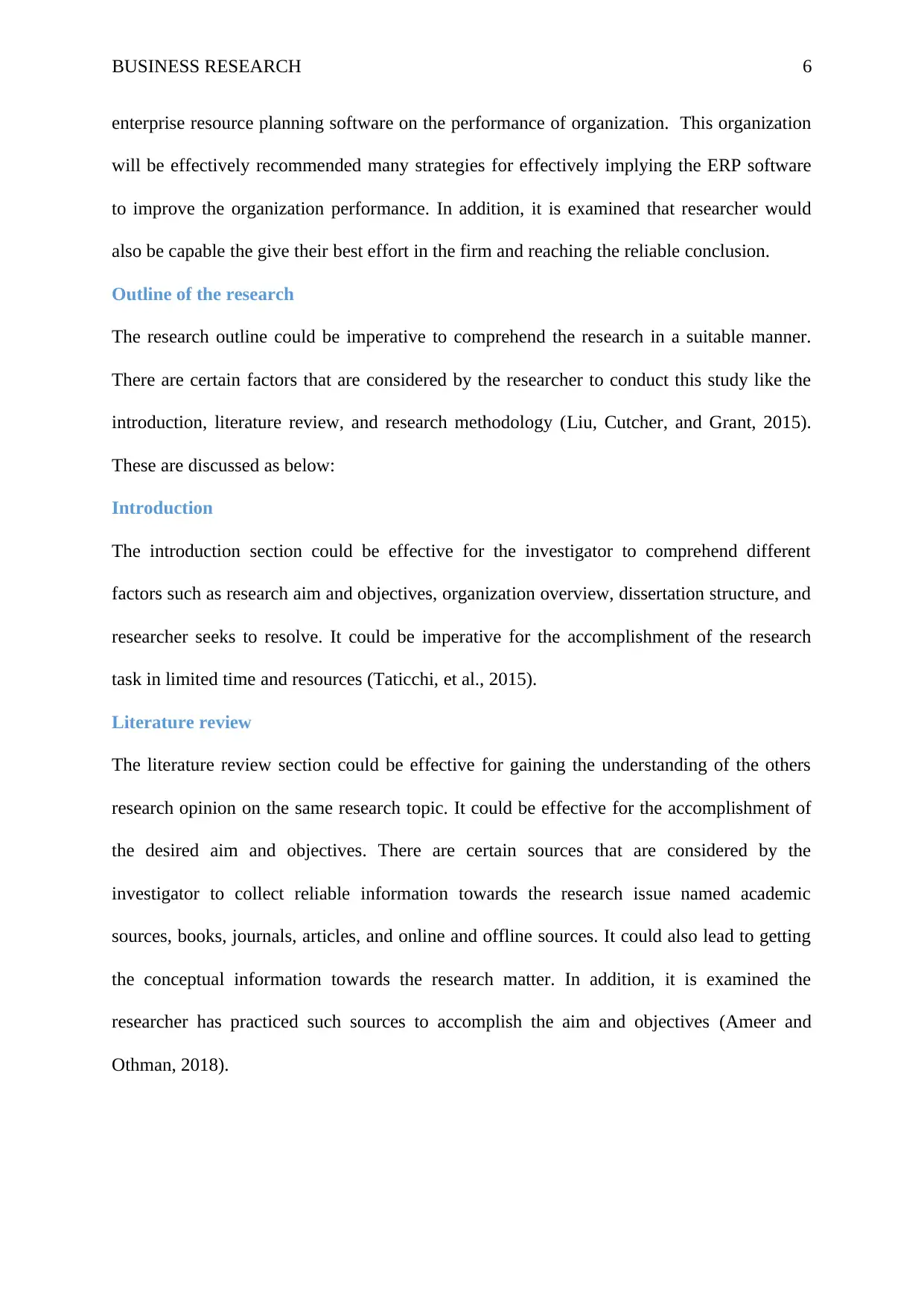
BUSINESS RESEARCH 6
enterprise resource planning software on the performance of organization. This organization
will be effectively recommended many strategies for effectively implying the ERP software
to improve the organization performance. In addition, it is examined that researcher would
also be capable the give their best effort in the firm and reaching the reliable conclusion.
Outline of the research
The research outline could be imperative to comprehend the research in a suitable manner.
There are certain factors that are considered by the researcher to conduct this study like the
introduction, literature review, and research methodology (Liu, Cutcher, and Grant, 2015).
These are discussed as below:
Introduction
The introduction section could be effective for the investigator to comprehend different
factors such as research aim and objectives, organization overview, dissertation structure, and
researcher seeks to resolve. It could be imperative for the accomplishment of the research
task in limited time and resources (Taticchi, et al., 2015).
Literature review
The literature review section could be effective for gaining the understanding of the others
research opinion on the same research topic. It could be effective for the accomplishment of
the desired aim and objectives. There are certain sources that are considered by the
investigator to collect reliable information towards the research issue named academic
sources, books, journals, articles, and online and offline sources. It could also lead to getting
the conceptual information towards the research matter. In addition, it is examined the
researcher has practiced such sources to accomplish the aim and objectives (Ameer and
Othman, 2018).
enterprise resource planning software on the performance of organization. This organization
will be effectively recommended many strategies for effectively implying the ERP software
to improve the organization performance. In addition, it is examined that researcher would
also be capable the give their best effort in the firm and reaching the reliable conclusion.
Outline of the research
The research outline could be imperative to comprehend the research in a suitable manner.
There are certain factors that are considered by the researcher to conduct this study like the
introduction, literature review, and research methodology (Liu, Cutcher, and Grant, 2015).
These are discussed as below:
Introduction
The introduction section could be effective for the investigator to comprehend different
factors such as research aim and objectives, organization overview, dissertation structure, and
researcher seeks to resolve. It could be imperative for the accomplishment of the research
task in limited time and resources (Taticchi, et al., 2015).
Literature review
The literature review section could be effective for gaining the understanding of the others
research opinion on the same research topic. It could be effective for the accomplishment of
the desired aim and objectives. There are certain sources that are considered by the
investigator to collect reliable information towards the research issue named academic
sources, books, journals, articles, and online and offline sources. It could also lead to getting
the conceptual information towards the research matter. In addition, it is examined the
researcher has practiced such sources to accomplish the aim and objectives (Ameer and
Othman, 2018).
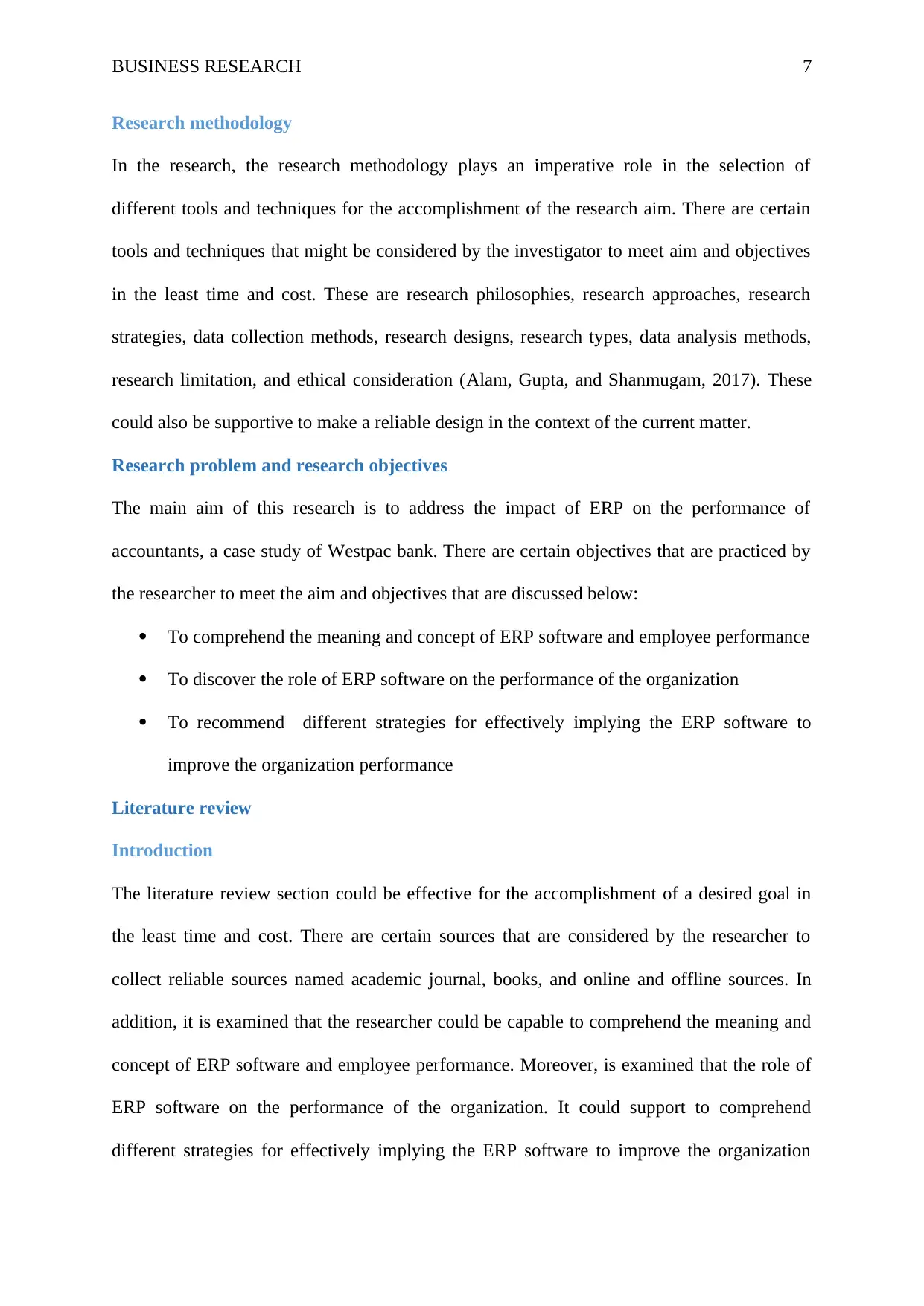
BUSINESS RESEARCH 7
Research methodology
In the research, the research methodology plays an imperative role in the selection of
different tools and techniques for the accomplishment of the research aim. There are certain
tools and techniques that might be considered by the investigator to meet aim and objectives
in the least time and cost. These are research philosophies, research approaches, research
strategies, data collection methods, research designs, research types, data analysis methods,
research limitation, and ethical consideration (Alam, Gupta, and Shanmugam, 2017). These
could also be supportive to make a reliable design in the context of the current matter.
Research problem and research objectives
The main aim of this research is to address the impact of ERP on the performance of
accountants, a case study of Westpac bank. There are certain objectives that are practiced by
the researcher to meet the aim and objectives that are discussed below:
To comprehend the meaning and concept of ERP software and employee performance
To discover the role of ERP software on the performance of the organization
To recommend different strategies for effectively implying the ERP software to
improve the organization performance
Literature review
Introduction
The literature review section could be effective for the accomplishment of a desired goal in
the least time and cost. There are certain sources that are considered by the researcher to
collect reliable sources named academic journal, books, and online and offline sources. In
addition, it is examined that the researcher could be capable to comprehend the meaning and
concept of ERP software and employee performance. Moreover, is examined that the role of
ERP software on the performance of the organization. It could support to comprehend
different strategies for effectively implying the ERP software to improve the organization
Research methodology
In the research, the research methodology plays an imperative role in the selection of
different tools and techniques for the accomplishment of the research aim. There are certain
tools and techniques that might be considered by the investigator to meet aim and objectives
in the least time and cost. These are research philosophies, research approaches, research
strategies, data collection methods, research designs, research types, data analysis methods,
research limitation, and ethical consideration (Alam, Gupta, and Shanmugam, 2017). These
could also be supportive to make a reliable design in the context of the current matter.
Research problem and research objectives
The main aim of this research is to address the impact of ERP on the performance of
accountants, a case study of Westpac bank. There are certain objectives that are practiced by
the researcher to meet the aim and objectives that are discussed below:
To comprehend the meaning and concept of ERP software and employee performance
To discover the role of ERP software on the performance of the organization
To recommend different strategies for effectively implying the ERP software to
improve the organization performance
Literature review
Introduction
The literature review section could be effective for the accomplishment of a desired goal in
the least time and cost. There are certain sources that are considered by the researcher to
collect reliable sources named academic journal, books, and online and offline sources. In
addition, it is examined that the researcher could be capable to comprehend the meaning and
concept of ERP software and employee performance. Moreover, is examined that the role of
ERP software on the performance of the organization. It could support to comprehend
different strategies for effectively implying the ERP software to improve the organization
Paraphrase This Document
Need a fresh take? Get an instant paraphrase of this document with our AI Paraphraser
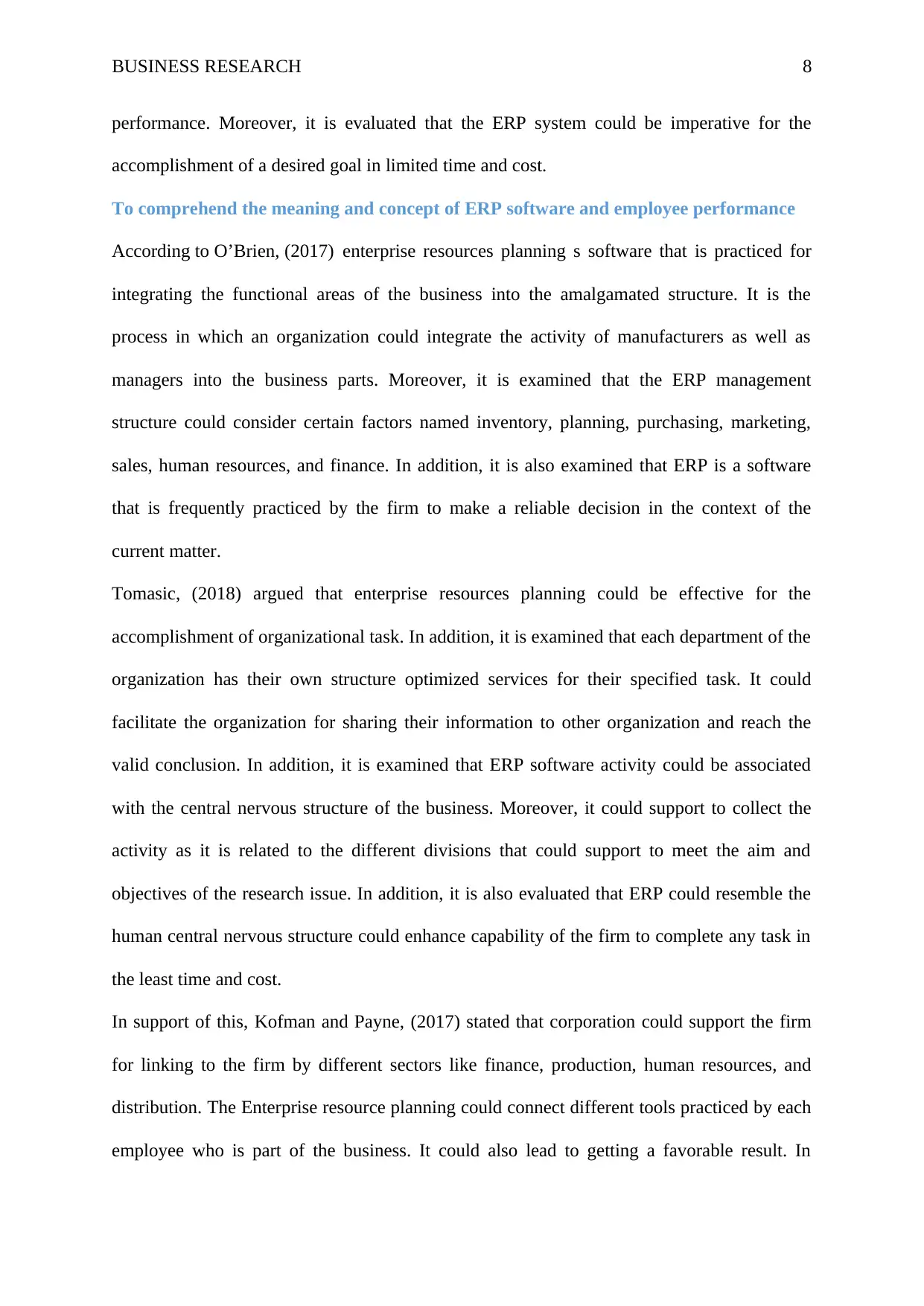
BUSINESS RESEARCH 8
performance. Moreover, it is evaluated that the ERP system could be imperative for the
accomplishment of a desired goal in limited time and cost.
To comprehend the meaning and concept of ERP software and employee performance
According to O’Brien, (2017) enterprise resources planning s software that is practiced for
integrating the functional areas of the business into the amalgamated structure. It is the
process in which an organization could integrate the activity of manufacturers as well as
managers into the business parts. Moreover, it is examined that the ERP management
structure could consider certain factors named inventory, planning, purchasing, marketing,
sales, human resources, and finance. In addition, it is also examined that ERP is a software
that is frequently practiced by the firm to make a reliable decision in the context of the
current matter.
Tomasic, (2018) argued that enterprise resources planning could be effective for the
accomplishment of organizational task. In addition, it is examined that each department of the
organization has their own structure optimized services for their specified task. It could
facilitate the organization for sharing their information to other organization and reach the
valid conclusion. In addition, it is examined that ERP software activity could be associated
with the central nervous structure of the business. Moreover, it could support to collect the
activity as it is related to the different divisions that could support to meet the aim and
objectives of the research issue. In addition, it is also evaluated that ERP could resemble the
human central nervous structure could enhance capability of the firm to complete any task in
the least time and cost.
In support of this, Kofman and Payne, (2017) stated that corporation could support the firm
for linking to the firm by different sectors like finance, production, human resources, and
distribution. The Enterprise resource planning could connect different tools practiced by each
employee who is part of the business. It could also lead to getting a favorable result. In
performance. Moreover, it is evaluated that the ERP system could be imperative for the
accomplishment of a desired goal in limited time and cost.
To comprehend the meaning and concept of ERP software and employee performance
According to O’Brien, (2017) enterprise resources planning s software that is practiced for
integrating the functional areas of the business into the amalgamated structure. It is the
process in which an organization could integrate the activity of manufacturers as well as
managers into the business parts. Moreover, it is examined that the ERP management
structure could consider certain factors named inventory, planning, purchasing, marketing,
sales, human resources, and finance. In addition, it is also examined that ERP is a software
that is frequently practiced by the firm to make a reliable decision in the context of the
current matter.
Tomasic, (2018) argued that enterprise resources planning could be effective for the
accomplishment of organizational task. In addition, it is examined that each department of the
organization has their own structure optimized services for their specified task. It could
facilitate the organization for sharing their information to other organization and reach the
valid conclusion. In addition, it is examined that ERP software activity could be associated
with the central nervous structure of the business. Moreover, it could support to collect the
activity as it is related to the different divisions that could support to meet the aim and
objectives of the research issue. In addition, it is also evaluated that ERP could resemble the
human central nervous structure could enhance capability of the firm to complete any task in
the least time and cost.
In support of this, Kofman and Payne, (2017) stated that corporation could support the firm
for linking to the firm by different sectors like finance, production, human resources, and
distribution. The Enterprise resource planning could connect different tools practiced by each
employee who is part of the business. It could also lead to getting a favorable result. In
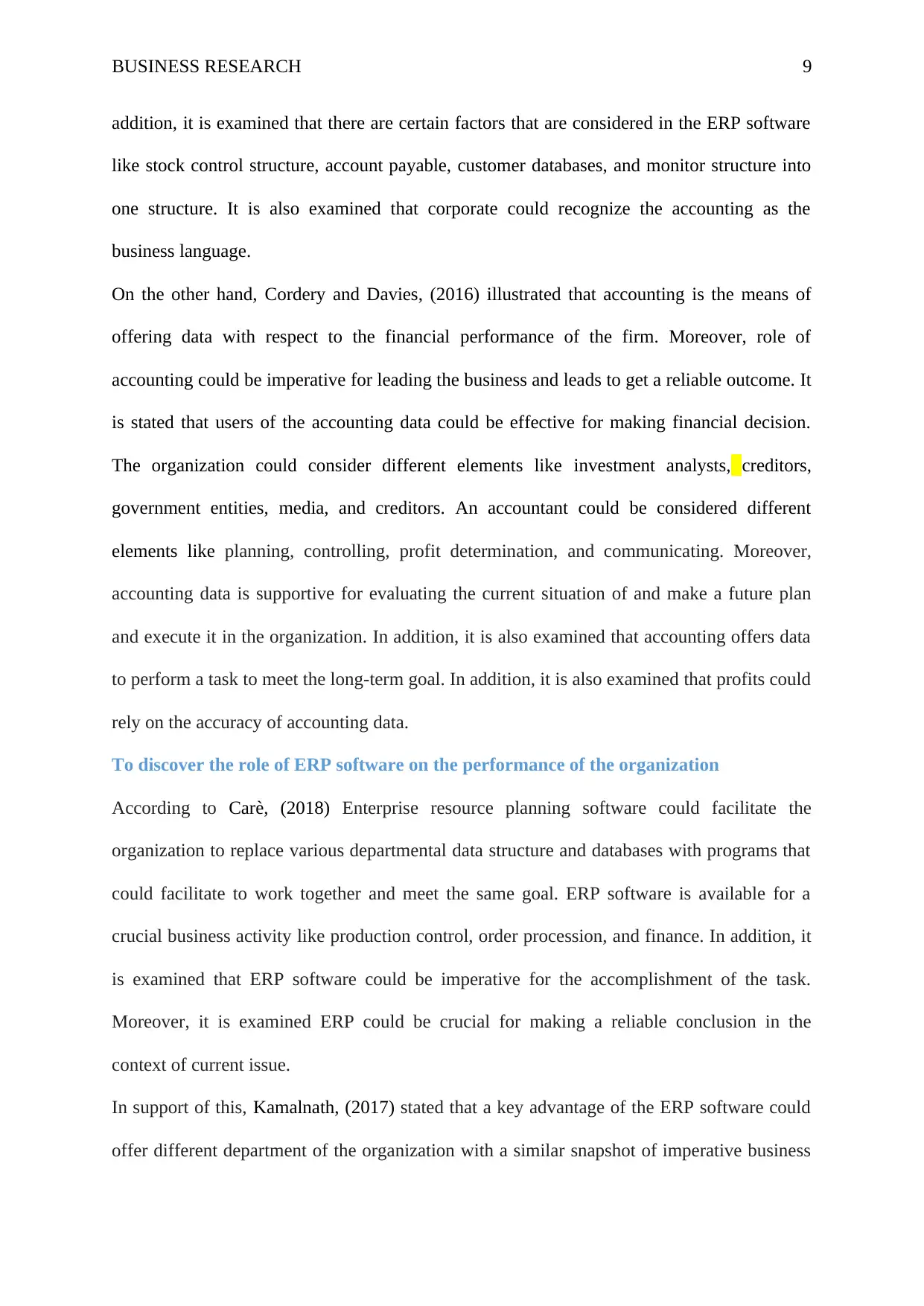
BUSINESS RESEARCH 9
addition, it is examined that there are certain factors that are considered in the ERP software
like stock control structure, account payable, customer databases, and monitor structure into
one structure. It is also examined that corporate could recognize the accounting as the
business language.
On the other hand, Cordery and Davies, (2016) illustrated that accounting is the means of
offering data with respect to the financial performance of the firm. Moreover, role of
accounting could be imperative for leading the business and leads to get a reliable outcome. It
is stated that users of the accounting data could be effective for making financial decision.
The organization could consider different elements like investment analysts, creditors,
government entities, media, and creditors. An accountant could be considered different
elements like planning, controlling, profit determination, and communicating. Moreover,
accounting data is supportive for evaluating the current situation of and make a future plan
and execute it in the organization. In addition, it is also examined that accounting offers data
to perform a task to meet the long-term goal. In addition, it is also examined that profits could
rely on the accuracy of accounting data.
To discover the role of ERP software on the performance of the organization
According to Carè, (2018) Enterprise resource planning software could facilitate the
organization to replace various departmental data structure and databases with programs that
could facilitate to work together and meet the same goal. ERP software is available for a
crucial business activity like production control, order procession, and finance. In addition, it
is examined that ERP software could be imperative for the accomplishment of the task.
Moreover, it is examined ERP could be crucial for making a reliable conclusion in the
context of current issue.
In support of this, Kamalnath, (2017) stated that a key advantage of the ERP software could
offer different department of the organization with a similar snapshot of imperative business
addition, it is examined that there are certain factors that are considered in the ERP software
like stock control structure, account payable, customer databases, and monitor structure into
one structure. It is also examined that corporate could recognize the accounting as the
business language.
On the other hand, Cordery and Davies, (2016) illustrated that accounting is the means of
offering data with respect to the financial performance of the firm. Moreover, role of
accounting could be imperative for leading the business and leads to get a reliable outcome. It
is stated that users of the accounting data could be effective for making financial decision.
The organization could consider different elements like investment analysts, creditors,
government entities, media, and creditors. An accountant could be considered different
elements like planning, controlling, profit determination, and communicating. Moreover,
accounting data is supportive for evaluating the current situation of and make a future plan
and execute it in the organization. In addition, it is also examined that accounting offers data
to perform a task to meet the long-term goal. In addition, it is also examined that profits could
rely on the accuracy of accounting data.
To discover the role of ERP software on the performance of the organization
According to Carè, (2018) Enterprise resource planning software could facilitate the
organization to replace various departmental data structure and databases with programs that
could facilitate to work together and meet the same goal. ERP software is available for a
crucial business activity like production control, order procession, and finance. In addition, it
is examined that ERP software could be imperative for the accomplishment of the task.
Moreover, it is examined ERP could be crucial for making a reliable conclusion in the
context of current issue.
In support of this, Kamalnath, (2017) stated that a key advantage of the ERP software could
offer different department of the organization with a similar snapshot of imperative business
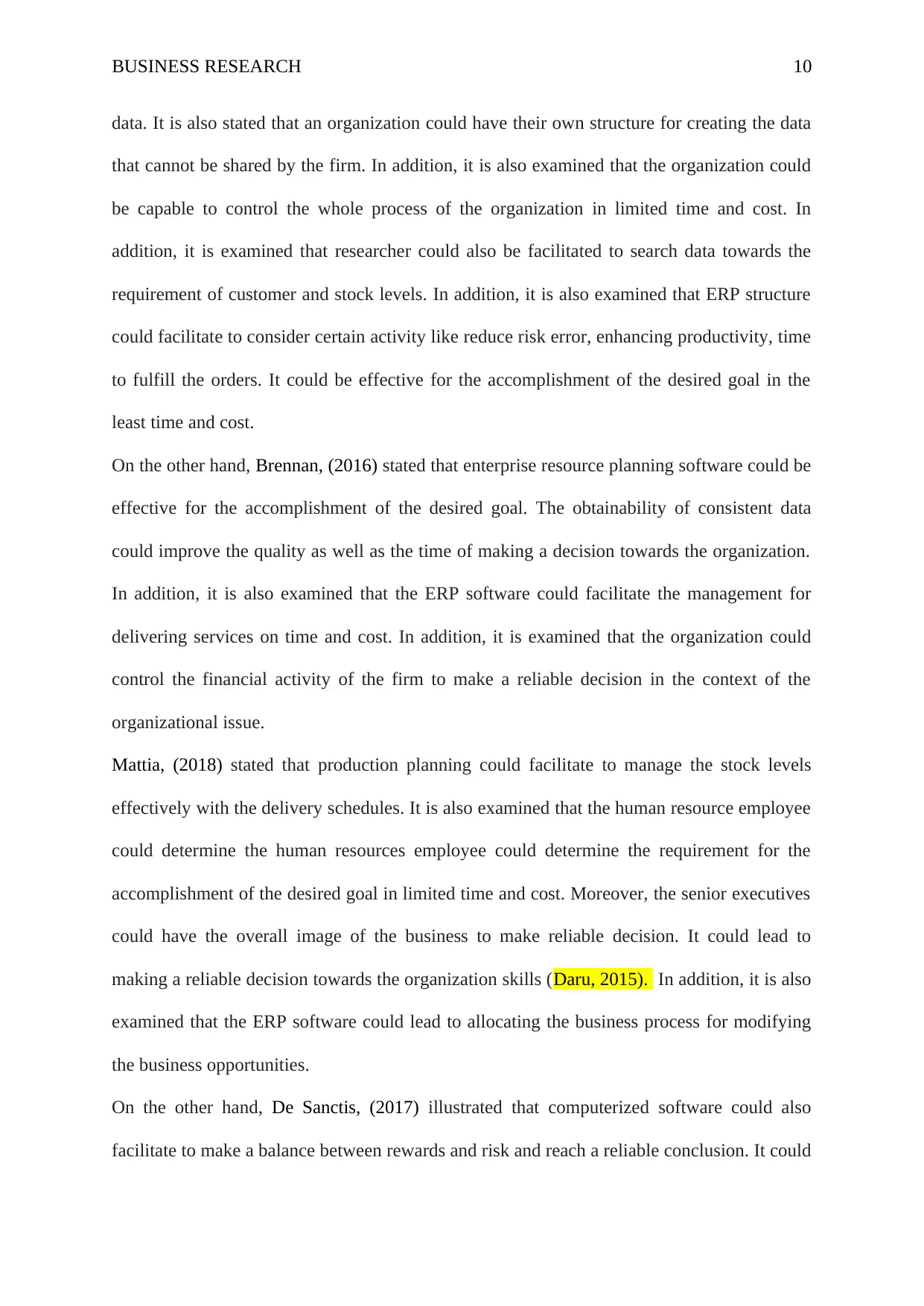
BUSINESS RESEARCH 10
data. It is also stated that an organization could have their own structure for creating the data
that cannot be shared by the firm. In addition, it is also examined that the organization could
be capable to control the whole process of the organization in limited time and cost. In
addition, it is examined that researcher could also be facilitated to search data towards the
requirement of customer and stock levels. In addition, it is also examined that ERP structure
could facilitate to consider certain activity like reduce risk error, enhancing productivity, time
to fulfill the orders. It could be effective for the accomplishment of the desired goal in the
least time and cost.
On the other hand, Brennan, (2016) stated that enterprise resource planning software could be
effective for the accomplishment of the desired goal. The obtainability of consistent data
could improve the quality as well as the time of making a decision towards the organization.
In addition, it is also examined that the ERP software could facilitate the management for
delivering services on time and cost. In addition, it is examined that the organization could
control the financial activity of the firm to make a reliable decision in the context of the
organizational issue.
Mattia, (2018) stated that production planning could facilitate to manage the stock levels
effectively with the delivery schedules. It is also examined that the human resource employee
could determine the human resources employee could determine the requirement for the
accomplishment of the desired goal in limited time and cost. Moreover, the senior executives
could have the overall image of the business to make reliable decision. It could lead to
making a reliable decision towards the organization skills (Daru, 2015). In addition, it is also
examined that the ERP software could lead to allocating the business process for modifying
the business opportunities.
On the other hand, De Sanctis, (2017) illustrated that computerized software could also
facilitate to make a balance between rewards and risk and reach a reliable conclusion. It could
data. It is also stated that an organization could have their own structure for creating the data
that cannot be shared by the firm. In addition, it is also examined that the organization could
be capable to control the whole process of the organization in limited time and cost. In
addition, it is examined that researcher could also be facilitated to search data towards the
requirement of customer and stock levels. In addition, it is also examined that ERP structure
could facilitate to consider certain activity like reduce risk error, enhancing productivity, time
to fulfill the orders. It could be effective for the accomplishment of the desired goal in the
least time and cost.
On the other hand, Brennan, (2016) stated that enterprise resource planning software could be
effective for the accomplishment of the desired goal. The obtainability of consistent data
could improve the quality as well as the time of making a decision towards the organization.
In addition, it is also examined that the ERP software could facilitate the management for
delivering services on time and cost. In addition, it is examined that the organization could
control the financial activity of the firm to make a reliable decision in the context of the
organizational issue.
Mattia, (2018) stated that production planning could facilitate to manage the stock levels
effectively with the delivery schedules. It is also examined that the human resource employee
could determine the human resources employee could determine the requirement for the
accomplishment of the desired goal in limited time and cost. Moreover, the senior executives
could have the overall image of the business to make reliable decision. It could lead to
making a reliable decision towards the organization skills (Daru, 2015). In addition, it is also
examined that the ERP software could lead to allocating the business process for modifying
the business opportunities.
On the other hand, De Sanctis, (2017) illustrated that computerized software could also
facilitate to make a balance between rewards and risk and reach a reliable conclusion. It could
Secure Best Marks with AI Grader
Need help grading? Try our AI Grader for instant feedback on your assignments.
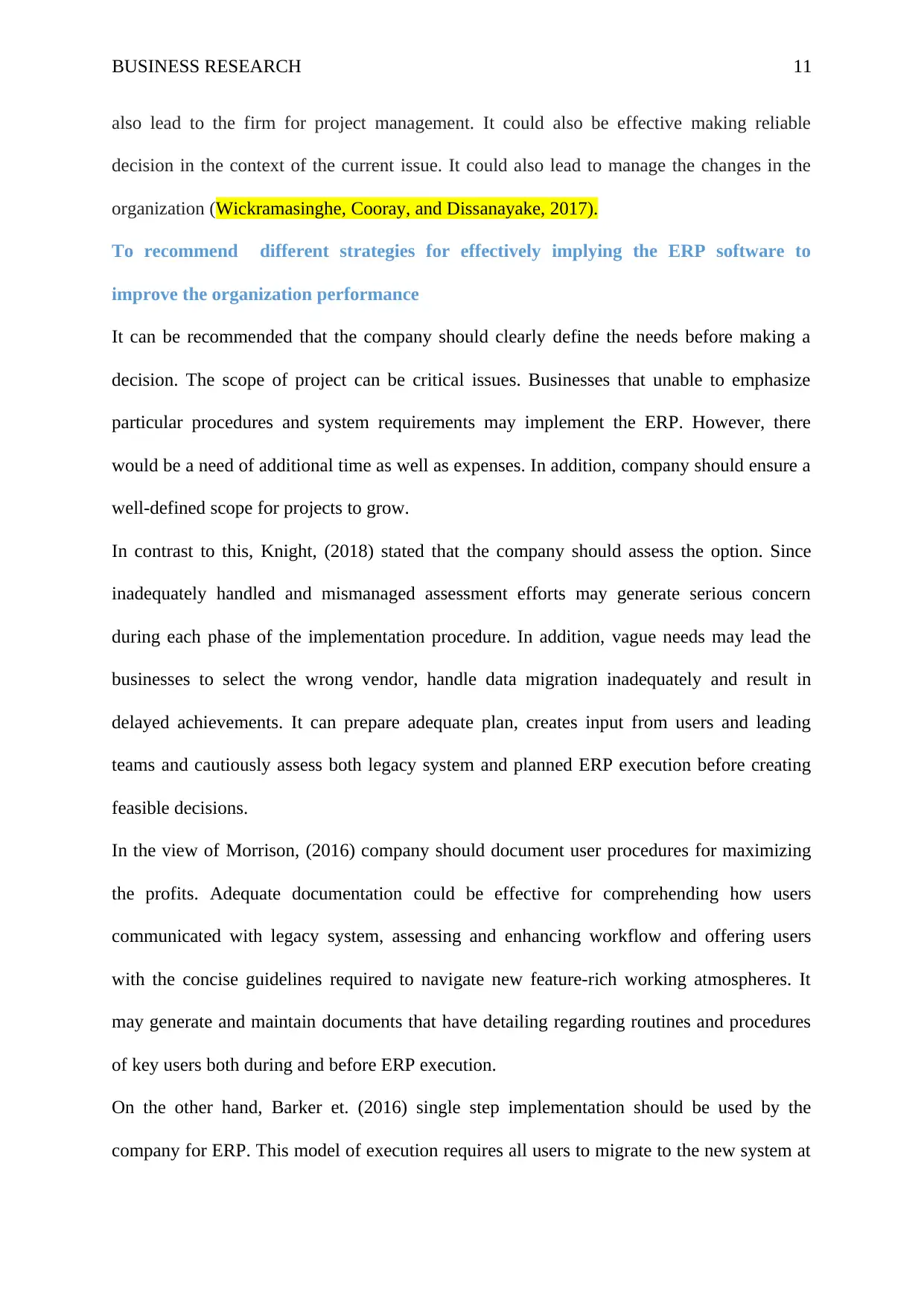
BUSINESS RESEARCH 11
also lead to the firm for project management. It could also be effective making reliable
decision in the context of the current issue. It could also lead to manage the changes in the
organization (Wickramasinghe, Cooray, and Dissanayake, 2017).
To recommend different strategies for effectively implying the ERP software to
improve the organization performance
It can be recommended that the company should clearly define the needs before making a
decision. The scope of project can be critical issues. Businesses that unable to emphasize
particular procedures and system requirements may implement the ERP. However, there
would be a need of additional time as well as expenses. In addition, company should ensure a
well-defined scope for projects to grow.
In contrast to this, Knight, (2018) stated that the company should assess the option. Since
inadequately handled and mismanaged assessment efforts may generate serious concern
during each phase of the implementation procedure. In addition, vague needs may lead the
businesses to select the wrong vendor, handle data migration inadequately and result in
delayed achievements. It can prepare adequate plan, creates input from users and leading
teams and cautiously assess both legacy system and planned ERP execution before creating
feasible decisions.
In the view of Morrison, (2016) company should document user procedures for maximizing
the profits. Adequate documentation could be effective for comprehending how users
communicated with legacy system, assessing and enhancing workflow and offering users
with the concise guidelines required to navigate new feature-rich working atmospheres. It
may generate and maintain documents that have detailing regarding routines and procedures
of key users both during and before ERP execution.
On the other hand, Barker et. (2016) single step implementation should be used by the
company for ERP. This model of execution requires all users to migrate to the new system at
also lead to the firm for project management. It could also be effective making reliable
decision in the context of the current issue. It could also lead to manage the changes in the
organization (Wickramasinghe, Cooray, and Dissanayake, 2017).
To recommend different strategies for effectively implying the ERP software to
improve the organization performance
It can be recommended that the company should clearly define the needs before making a
decision. The scope of project can be critical issues. Businesses that unable to emphasize
particular procedures and system requirements may implement the ERP. However, there
would be a need of additional time as well as expenses. In addition, company should ensure a
well-defined scope for projects to grow.
In contrast to this, Knight, (2018) stated that the company should assess the option. Since
inadequately handled and mismanaged assessment efforts may generate serious concern
during each phase of the implementation procedure. In addition, vague needs may lead the
businesses to select the wrong vendor, handle data migration inadequately and result in
delayed achievements. It can prepare adequate plan, creates input from users and leading
teams and cautiously assess both legacy system and planned ERP execution before creating
feasible decisions.
In the view of Morrison, (2016) company should document user procedures for maximizing
the profits. Adequate documentation could be effective for comprehending how users
communicated with legacy system, assessing and enhancing workflow and offering users
with the concise guidelines required to navigate new feature-rich working atmospheres. It
may generate and maintain documents that have detailing regarding routines and procedures
of key users both during and before ERP execution.
On the other hand, Barker et. (2016) single step implementation should be used by the
company for ERP. This model of execution requires all users to migrate to the new system at
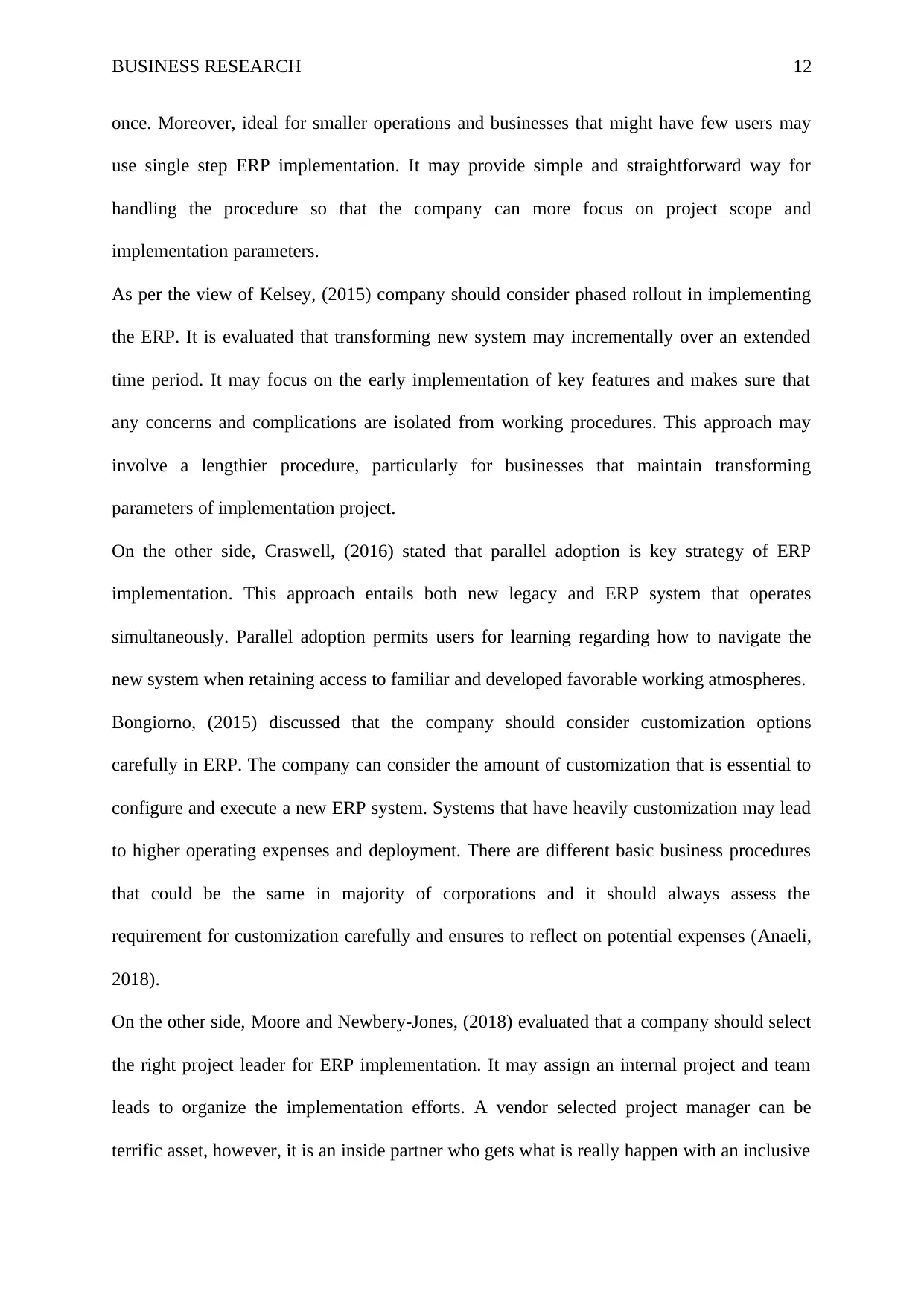
BUSINESS RESEARCH 12
once. Moreover, ideal for smaller operations and businesses that might have few users may
use single step ERP implementation. It may provide simple and straightforward way for
handling the procedure so that the company can more focus on project scope and
implementation parameters.
As per the view of Kelsey, (2015) company should consider phased rollout in implementing
the ERP. It is evaluated that transforming new system may incrementally over an extended
time period. It may focus on the early implementation of key features and makes sure that
any concerns and complications are isolated from working procedures. This approach may
involve a lengthier procedure, particularly for businesses that maintain transforming
parameters of implementation project.
On the other side, Craswell, (2016) stated that parallel adoption is key strategy of ERP
implementation. This approach entails both new legacy and ERP system that operates
simultaneously. Parallel adoption permits users for learning regarding how to navigate the
new system when retaining access to familiar and developed favorable working atmospheres.
Bongiorno, (2015) discussed that the company should consider customization options
carefully in ERP. The company can consider the amount of customization that is essential to
configure and execute a new ERP system. Systems that have heavily customization may lead
to higher operating expenses and deployment. There are different basic business procedures
that could be the same in majority of corporations and it should always assess the
requirement for customization carefully and ensures to reflect on potential expenses (Anaeli,
2018).
On the other side, Moore and Newbery-Jones, (2018) evaluated that a company should select
the right project leader for ERP implementation. It may assign an internal project and team
leads to organize the implementation efforts. A vendor selected project manager can be
terrific asset, however, it is an inside partner who gets what is really happen with an inclusive
once. Moreover, ideal for smaller operations and businesses that might have few users may
use single step ERP implementation. It may provide simple and straightforward way for
handling the procedure so that the company can more focus on project scope and
implementation parameters.
As per the view of Kelsey, (2015) company should consider phased rollout in implementing
the ERP. It is evaluated that transforming new system may incrementally over an extended
time period. It may focus on the early implementation of key features and makes sure that
any concerns and complications are isolated from working procedures. This approach may
involve a lengthier procedure, particularly for businesses that maintain transforming
parameters of implementation project.
On the other side, Craswell, (2016) stated that parallel adoption is key strategy of ERP
implementation. This approach entails both new legacy and ERP system that operates
simultaneously. Parallel adoption permits users for learning regarding how to navigate the
new system when retaining access to familiar and developed favorable working atmospheres.
Bongiorno, (2015) discussed that the company should consider customization options
carefully in ERP. The company can consider the amount of customization that is essential to
configure and execute a new ERP system. Systems that have heavily customization may lead
to higher operating expenses and deployment. There are different basic business procedures
that could be the same in majority of corporations and it should always assess the
requirement for customization carefully and ensures to reflect on potential expenses (Anaeli,
2018).
On the other side, Moore and Newbery-Jones, (2018) evaluated that a company should select
the right project leader for ERP implementation. It may assign an internal project and team
leads to organize the implementation efforts. A vendor selected project manager can be
terrific asset, however, it is an inside partner who gets what is really happen with an inclusive
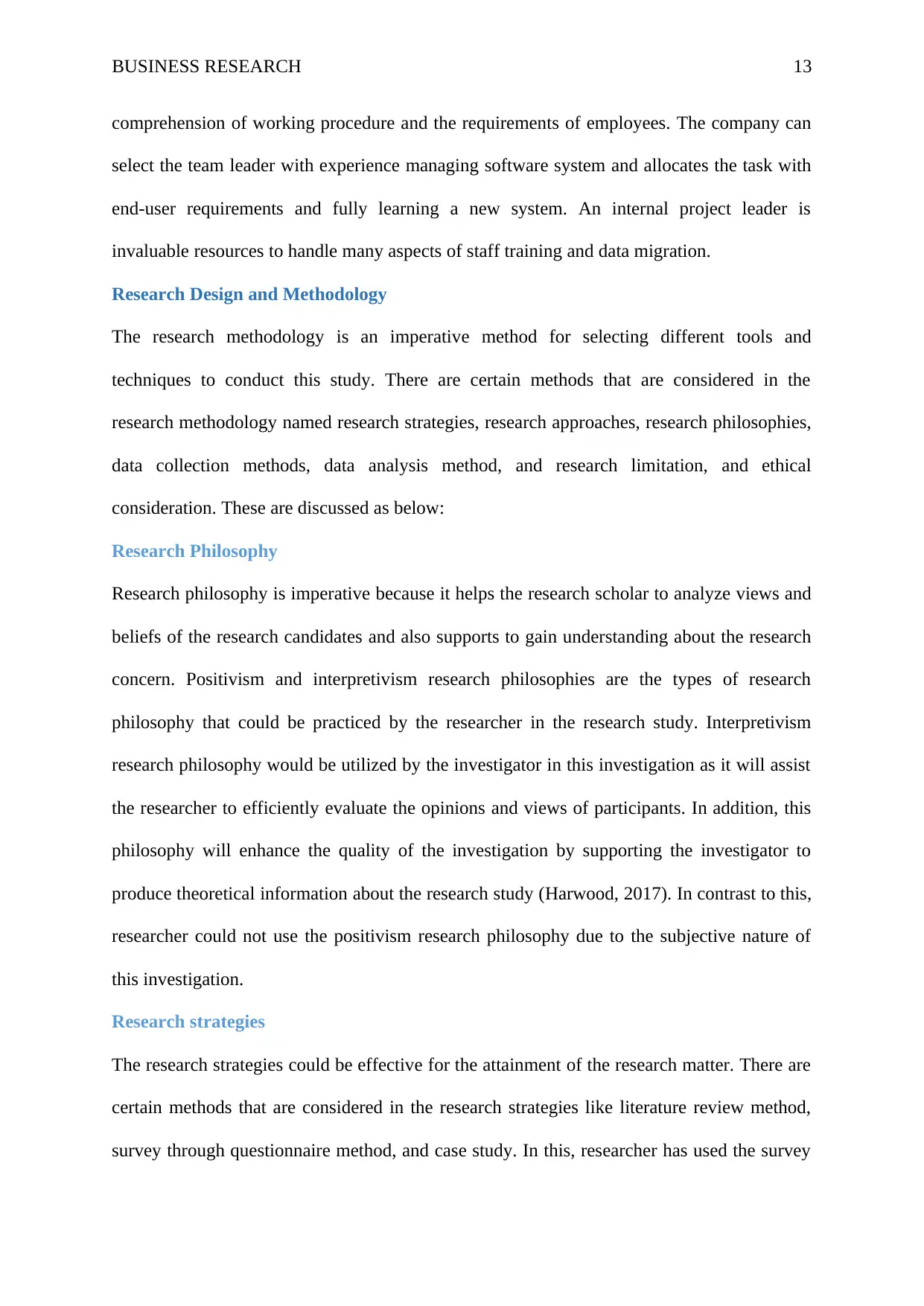
BUSINESS RESEARCH 13
comprehension of working procedure and the requirements of employees. The company can
select the team leader with experience managing software system and allocates the task with
end-user requirements and fully learning a new system. An internal project leader is
invaluable resources to handle many aspects of staff training and data migration.
Research Design and Methodology
The research methodology is an imperative method for selecting different tools and
techniques to conduct this study. There are certain methods that are considered in the
research methodology named research strategies, research approaches, research philosophies,
data collection methods, data analysis method, and research limitation, and ethical
consideration. These are discussed as below:
Research Philosophy
Research philosophy is imperative because it helps the research scholar to analyze views and
beliefs of the research candidates and also supports to gain understanding about the research
concern. Positivism and interpretivism research philosophies are the types of research
philosophy that could be practiced by the researcher in the research study. Interpretivism
research philosophy would be utilized by the investigator in this investigation as it will assist
the researcher to efficiently evaluate the opinions and views of participants. In addition, this
philosophy will enhance the quality of the investigation by supporting the investigator to
produce theoretical information about the research study (Harwood, 2017). In contrast to this,
researcher could not use the positivism research philosophy due to the subjective nature of
this investigation.
Research strategies
The research strategies could be effective for the attainment of the research matter. There are
certain methods that are considered in the research strategies like literature review method,
survey through questionnaire method, and case study. In this, researcher has used the survey
comprehension of working procedure and the requirements of employees. The company can
select the team leader with experience managing software system and allocates the task with
end-user requirements and fully learning a new system. An internal project leader is
invaluable resources to handle many aspects of staff training and data migration.
Research Design and Methodology
The research methodology is an imperative method for selecting different tools and
techniques to conduct this study. There are certain methods that are considered in the
research methodology named research strategies, research approaches, research philosophies,
data collection methods, data analysis method, and research limitation, and ethical
consideration. These are discussed as below:
Research Philosophy
Research philosophy is imperative because it helps the research scholar to analyze views and
beliefs of the research candidates and also supports to gain understanding about the research
concern. Positivism and interpretivism research philosophies are the types of research
philosophy that could be practiced by the researcher in the research study. Interpretivism
research philosophy would be utilized by the investigator in this investigation as it will assist
the researcher to efficiently evaluate the opinions and views of participants. In addition, this
philosophy will enhance the quality of the investigation by supporting the investigator to
produce theoretical information about the research study (Harwood, 2017). In contrast to this,
researcher could not use the positivism research philosophy due to the subjective nature of
this investigation.
Research strategies
The research strategies could be effective for the attainment of the research matter. There are
certain methods that are considered in the research strategies like literature review method,
survey through questionnaire method, and case study. In this, researcher has used the survey
Paraphrase This Document
Need a fresh take? Get an instant paraphrase of this document with our AI Paraphraser
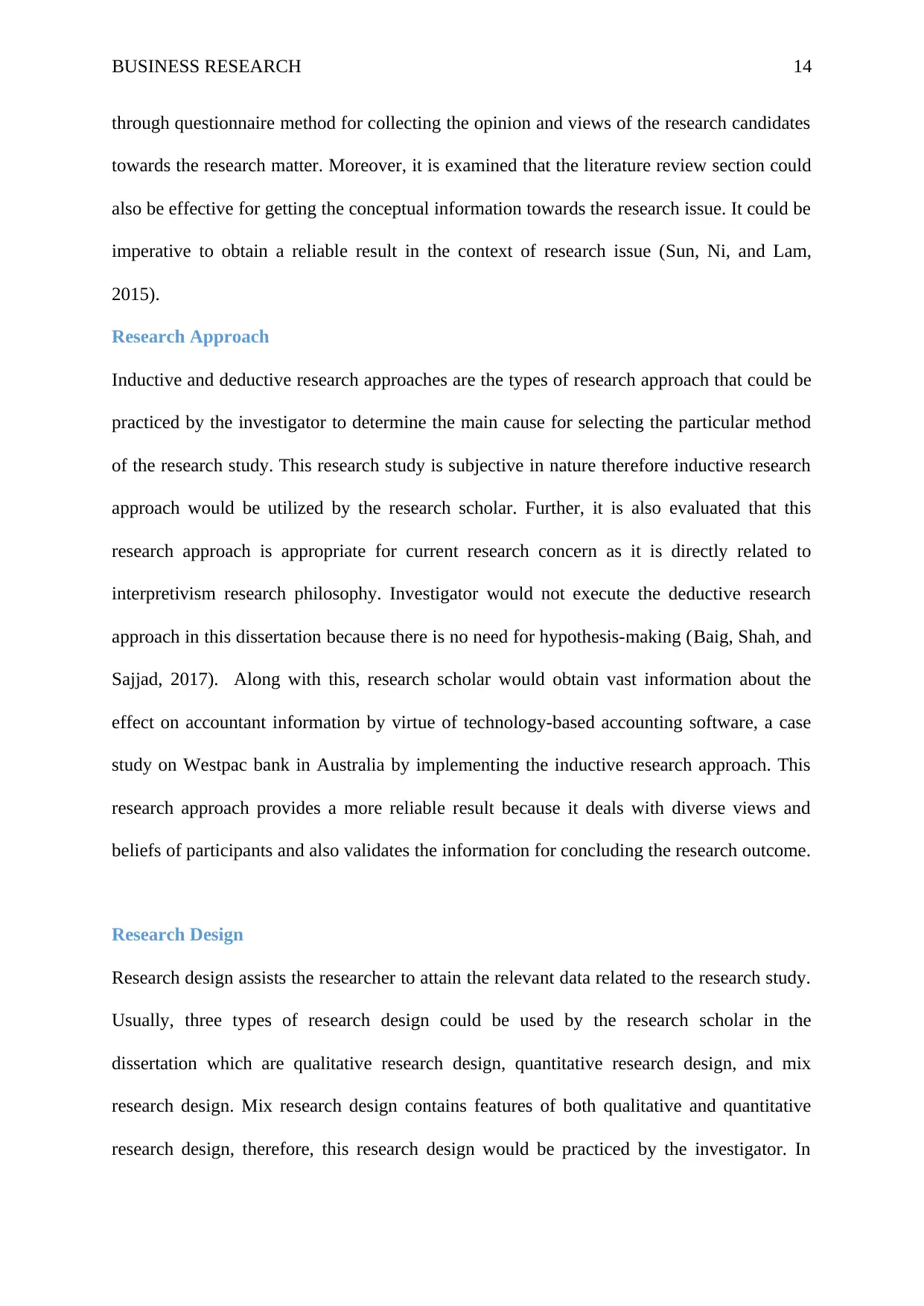
BUSINESS RESEARCH 14
through questionnaire method for collecting the opinion and views of the research candidates
towards the research matter. Moreover, it is examined that the literature review section could
also be effective for getting the conceptual information towards the research issue. It could be
imperative to obtain a reliable result in the context of research issue (Sun, Ni, and Lam,
2015).
Research Approach
Inductive and deductive research approaches are the types of research approach that could be
practiced by the investigator to determine the main cause for selecting the particular method
of the research study. This research study is subjective in nature therefore inductive research
approach would be utilized by the research scholar. Further, it is also evaluated that this
research approach is appropriate for current research concern as it is directly related to
interpretivism research philosophy. Investigator would not execute the deductive research
approach in this dissertation because there is no need for hypothesis-making (Baig, Shah, and
Sajjad, 2017). Along with this, research scholar would obtain vast information about the
effect on accountant information by virtue of technology-based accounting software, a case
study on Westpac bank in Australia by implementing the inductive research approach. This
research approach provides a more reliable result because it deals with diverse views and
beliefs of participants and also validates the information for concluding the research outcome.
Research Design
Research design assists the researcher to attain the relevant data related to the research study.
Usually, three types of research design could be used by the research scholar in the
dissertation which are qualitative research design, quantitative research design, and mix
research design. Mix research design contains features of both qualitative and quantitative
research design, therefore, this research design would be practiced by the investigator. In
through questionnaire method for collecting the opinion and views of the research candidates
towards the research matter. Moreover, it is examined that the literature review section could
also be effective for getting the conceptual information towards the research issue. It could be
imperative to obtain a reliable result in the context of research issue (Sun, Ni, and Lam,
2015).
Research Approach
Inductive and deductive research approaches are the types of research approach that could be
practiced by the investigator to determine the main cause for selecting the particular method
of the research study. This research study is subjective in nature therefore inductive research
approach would be utilized by the research scholar. Further, it is also evaluated that this
research approach is appropriate for current research concern as it is directly related to
interpretivism research philosophy. Investigator would not execute the deductive research
approach in this dissertation because there is no need for hypothesis-making (Baig, Shah, and
Sajjad, 2017). Along with this, research scholar would obtain vast information about the
effect on accountant information by virtue of technology-based accounting software, a case
study on Westpac bank in Australia by implementing the inductive research approach. This
research approach provides a more reliable result because it deals with diverse views and
beliefs of participants and also validates the information for concluding the research outcome.
Research Design
Research design assists the researcher to attain the relevant data related to the research study.
Usually, three types of research design could be used by the research scholar in the
dissertation which are qualitative research design, quantitative research design, and mix
research design. Mix research design contains features of both qualitative and quantitative
research design, therefore, this research design would be practiced by the investigator. In
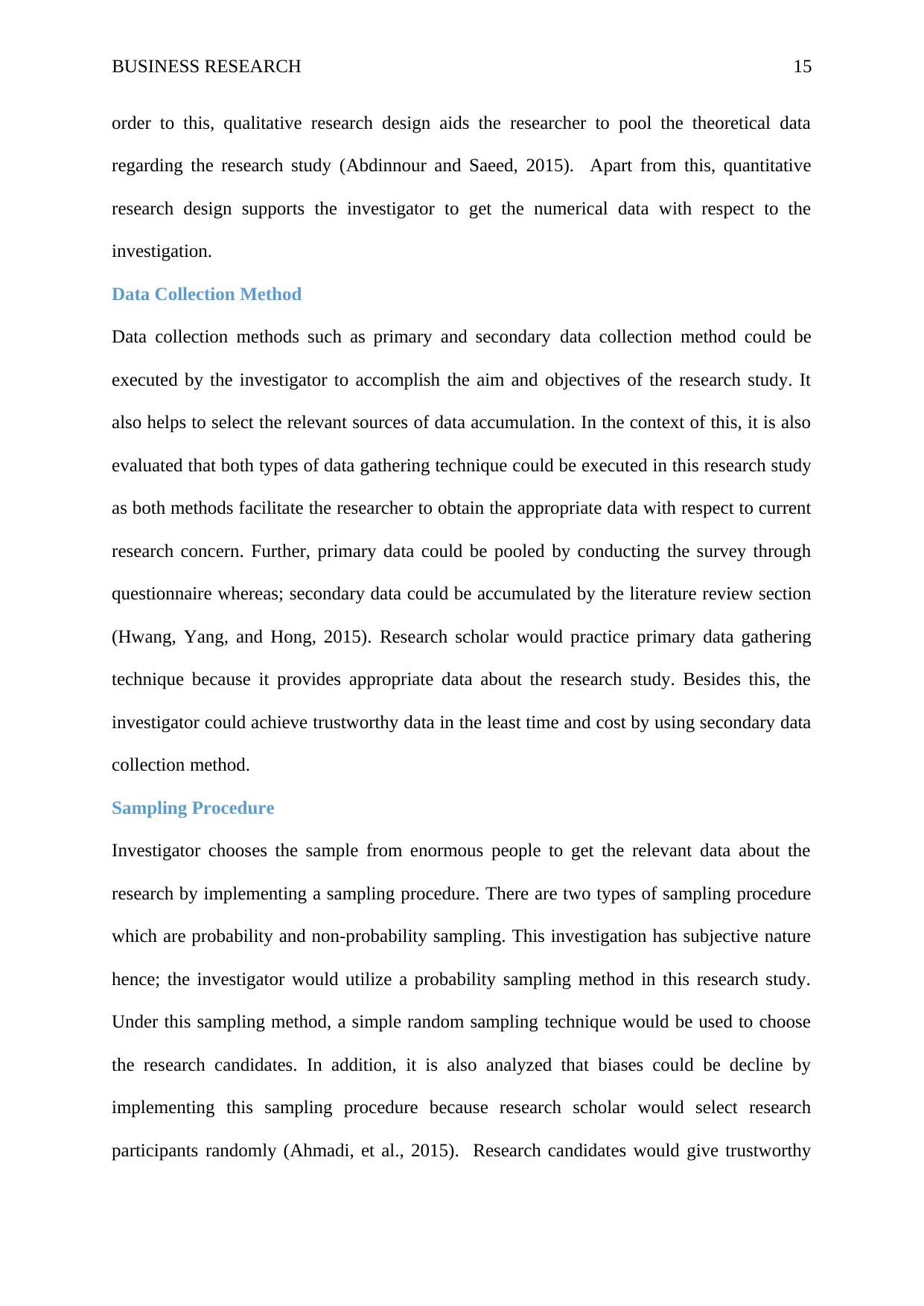
BUSINESS RESEARCH 15
order to this, qualitative research design aids the researcher to pool the theoretical data
regarding the research study (Abdinnour and Saeed, 2015). Apart from this, quantitative
research design supports the investigator to get the numerical data with respect to the
investigation.
Data Collection Method
Data collection methods such as primary and secondary data collection method could be
executed by the investigator to accomplish the aim and objectives of the research study. It
also helps to select the relevant sources of data accumulation. In the context of this, it is also
evaluated that both types of data gathering technique could be executed in this research study
as both methods facilitate the researcher to obtain the appropriate data with respect to current
research concern. Further, primary data could be pooled by conducting the survey through
questionnaire whereas; secondary data could be accumulated by the literature review section
(Hwang, Yang, and Hong, 2015). Research scholar would practice primary data gathering
technique because it provides appropriate data about the research study. Besides this, the
investigator could achieve trustworthy data in the least time and cost by using secondary data
collection method.
Sampling Procedure
Investigator chooses the sample from enormous people to get the relevant data about the
research by implementing a sampling procedure. There are two types of sampling procedure
which are probability and non-probability sampling. This investigation has subjective nature
hence; the investigator would utilize a probability sampling method in this research study.
Under this sampling method, a simple random sampling technique would be used to choose
the research candidates. In addition, it is also analyzed that biases could be decline by
implementing this sampling procedure because research scholar would select research
participants randomly (Ahmadi, et al., 2015). Research candidates would give trustworthy
order to this, qualitative research design aids the researcher to pool the theoretical data
regarding the research study (Abdinnour and Saeed, 2015). Apart from this, quantitative
research design supports the investigator to get the numerical data with respect to the
investigation.
Data Collection Method
Data collection methods such as primary and secondary data collection method could be
executed by the investigator to accomplish the aim and objectives of the research study. It
also helps to select the relevant sources of data accumulation. In the context of this, it is also
evaluated that both types of data gathering technique could be executed in this research study
as both methods facilitate the researcher to obtain the appropriate data with respect to current
research concern. Further, primary data could be pooled by conducting the survey through
questionnaire whereas; secondary data could be accumulated by the literature review section
(Hwang, Yang, and Hong, 2015). Research scholar would practice primary data gathering
technique because it provides appropriate data about the research study. Besides this, the
investigator could achieve trustworthy data in the least time and cost by using secondary data
collection method.
Sampling Procedure
Investigator chooses the sample from enormous people to get the relevant data about the
research by implementing a sampling procedure. There are two types of sampling procedure
which are probability and non-probability sampling. This investigation has subjective nature
hence; the investigator would utilize a probability sampling method in this research study.
Under this sampling method, a simple random sampling technique would be used to choose
the research candidates. In addition, it is also analyzed that biases could be decline by
implementing this sampling procedure because research scholar would select research
participants randomly (Ahmadi, et al., 2015). Research candidates would give trustworthy
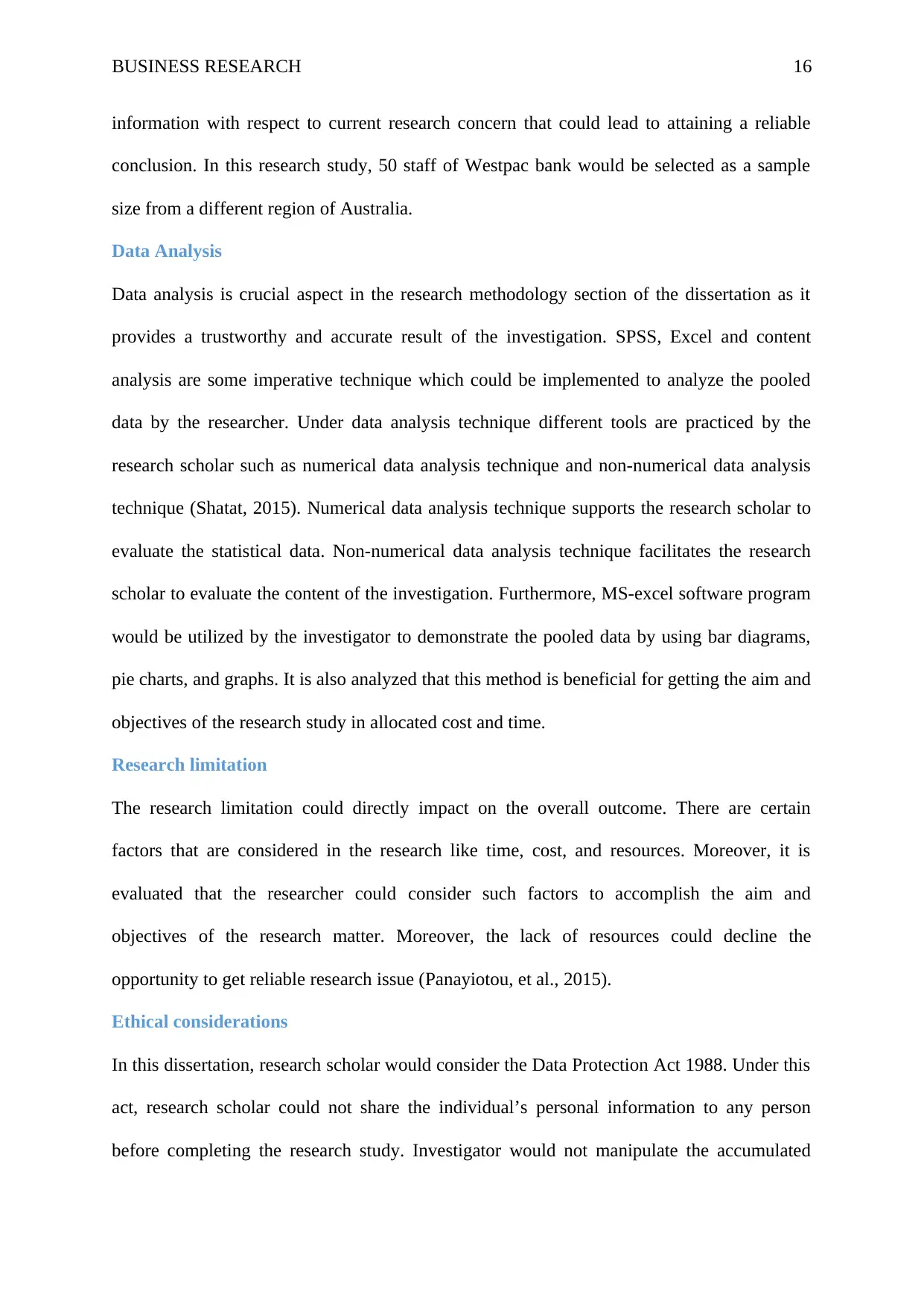
BUSINESS RESEARCH 16
information with respect to current research concern that could lead to attaining a reliable
conclusion. In this research study, 50 staff of Westpac bank would be selected as a sample
size from a different region of Australia.
Data Analysis
Data analysis is crucial aspect in the research methodology section of the dissertation as it
provides a trustworthy and accurate result of the investigation. SPSS, Excel and content
analysis are some imperative technique which could be implemented to analyze the pooled
data by the researcher. Under data analysis technique different tools are practiced by the
research scholar such as numerical data analysis technique and non-numerical data analysis
technique (Shatat, 2015). Numerical data analysis technique supports the research scholar to
evaluate the statistical data. Non-numerical data analysis technique facilitates the research
scholar to evaluate the content of the investigation. Furthermore, MS-excel software program
would be utilized by the investigator to demonstrate the pooled data by using bar diagrams,
pie charts, and graphs. It is also analyzed that this method is beneficial for getting the aim and
objectives of the research study in allocated cost and time.
Research limitation
The research limitation could directly impact on the overall outcome. There are certain
factors that are considered in the research like time, cost, and resources. Moreover, it is
evaluated that the researcher could consider such factors to accomplish the aim and
objectives of the research matter. Moreover, the lack of resources could decline the
opportunity to get reliable research issue (Panayiotou, et al., 2015).
Ethical considerations
In this dissertation, research scholar would consider the Data Protection Act 1988. Under this
act, research scholar could not share the individual’s personal information to any person
before completing the research study. Investigator would not manipulate the accumulated
information with respect to current research concern that could lead to attaining a reliable
conclusion. In this research study, 50 staff of Westpac bank would be selected as a sample
size from a different region of Australia.
Data Analysis
Data analysis is crucial aspect in the research methodology section of the dissertation as it
provides a trustworthy and accurate result of the investigation. SPSS, Excel and content
analysis are some imperative technique which could be implemented to analyze the pooled
data by the researcher. Under data analysis technique different tools are practiced by the
research scholar such as numerical data analysis technique and non-numerical data analysis
technique (Shatat, 2015). Numerical data analysis technique supports the research scholar to
evaluate the statistical data. Non-numerical data analysis technique facilitates the research
scholar to evaluate the content of the investigation. Furthermore, MS-excel software program
would be utilized by the investigator to demonstrate the pooled data by using bar diagrams,
pie charts, and graphs. It is also analyzed that this method is beneficial for getting the aim and
objectives of the research study in allocated cost and time.
Research limitation
The research limitation could directly impact on the overall outcome. There are certain
factors that are considered in the research like time, cost, and resources. Moreover, it is
evaluated that the researcher could consider such factors to accomplish the aim and
objectives of the research matter. Moreover, the lack of resources could decline the
opportunity to get reliable research issue (Panayiotou, et al., 2015).
Ethical considerations
In this dissertation, research scholar would consider the Data Protection Act 1988. Under this
act, research scholar could not share the individual’s personal information to any person
before completing the research study. Investigator would not manipulate the accumulated
Secure Best Marks with AI Grader
Need help grading? Try our AI Grader for instant feedback on your assignments.

BUSINESS RESEARCH 17
data that are gathered by the research participants and cannot influence anyone for sharing
their personal information. Investigator would inform the managers about the purpose of
investigation for getting the accurate information and their involvement before collecting data
from managers (Panayiotou, et al., 2015).
data that are gathered by the research participants and cannot influence anyone for sharing
their personal information. Investigator would inform the managers about the purpose of
investigation for getting the accurate information and their involvement before collecting data
from managers (Panayiotou, et al., 2015).
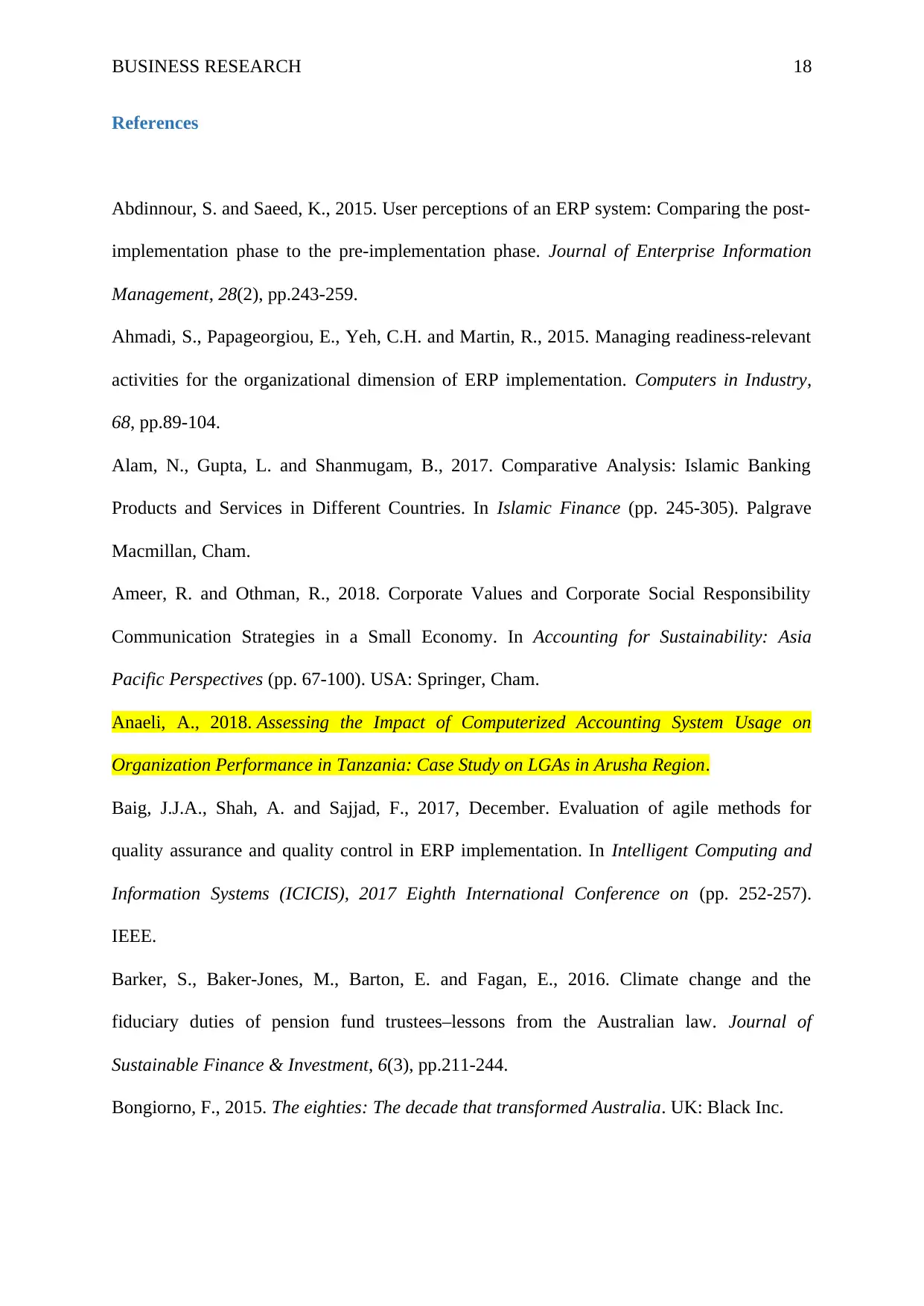
BUSINESS RESEARCH 18
References
Abdinnour, S. and Saeed, K., 2015. User perceptions of an ERP system: Comparing the post-
implementation phase to the pre-implementation phase. Journal of Enterprise Information
Management, 28(2), pp.243-259.
Ahmadi, S., Papageorgiou, E., Yeh, C.H. and Martin, R., 2015. Managing readiness-relevant
activities for the organizational dimension of ERP implementation. Computers in Industry,
68, pp.89-104.
Alam, N., Gupta, L. and Shanmugam, B., 2017. Comparative Analysis: Islamic Banking
Products and Services in Different Countries. In Islamic Finance (pp. 245-305). Palgrave
Macmillan, Cham.
Ameer, R. and Othman, R., 2018. Corporate Values and Corporate Social Responsibility
Communication Strategies in a Small Economy. In Accounting for Sustainability: Asia
Pacific Perspectives (pp. 67-100). USA: Springer, Cham.
Anaeli, A., 2018. Assessing the Impact of Computerized Accounting System Usage on
Organization Performance in Tanzania: Case Study on LGAs in Arusha Region.
Baig, J.J.A., Shah, A. and Sajjad, F., 2017, December. Evaluation of agile methods for
quality assurance and quality control in ERP implementation. In Intelligent Computing and
Information Systems (ICICIS), 2017 Eighth International Conference on (pp. 252-257).
IEEE.
Barker, S., Baker-Jones, M., Barton, E. and Fagan, E., 2016. Climate change and the
fiduciary duties of pension fund trustees–lessons from the Australian law. Journal of
Sustainable Finance & Investment, 6(3), pp.211-244.
Bongiorno, F., 2015. The eighties: The decade that transformed Australia. UK: Black Inc.
References
Abdinnour, S. and Saeed, K., 2015. User perceptions of an ERP system: Comparing the post-
implementation phase to the pre-implementation phase. Journal of Enterprise Information
Management, 28(2), pp.243-259.
Ahmadi, S., Papageorgiou, E., Yeh, C.H. and Martin, R., 2015. Managing readiness-relevant
activities for the organizational dimension of ERP implementation. Computers in Industry,
68, pp.89-104.
Alam, N., Gupta, L. and Shanmugam, B., 2017. Comparative Analysis: Islamic Banking
Products and Services in Different Countries. In Islamic Finance (pp. 245-305). Palgrave
Macmillan, Cham.
Ameer, R. and Othman, R., 2018. Corporate Values and Corporate Social Responsibility
Communication Strategies in a Small Economy. In Accounting for Sustainability: Asia
Pacific Perspectives (pp. 67-100). USA: Springer, Cham.
Anaeli, A., 2018. Assessing the Impact of Computerized Accounting System Usage on
Organization Performance in Tanzania: Case Study on LGAs in Arusha Region.
Baig, J.J.A., Shah, A. and Sajjad, F., 2017, December. Evaluation of agile methods for
quality assurance and quality control in ERP implementation. In Intelligent Computing and
Information Systems (ICICIS), 2017 Eighth International Conference on (pp. 252-257).
IEEE.
Barker, S., Baker-Jones, M., Barton, E. and Fagan, E., 2016. Climate change and the
fiduciary duties of pension fund trustees–lessons from the Australian law. Journal of
Sustainable Finance & Investment, 6(3), pp.211-244.
Bongiorno, F., 2015. The eighties: The decade that transformed Australia. UK: Black Inc.
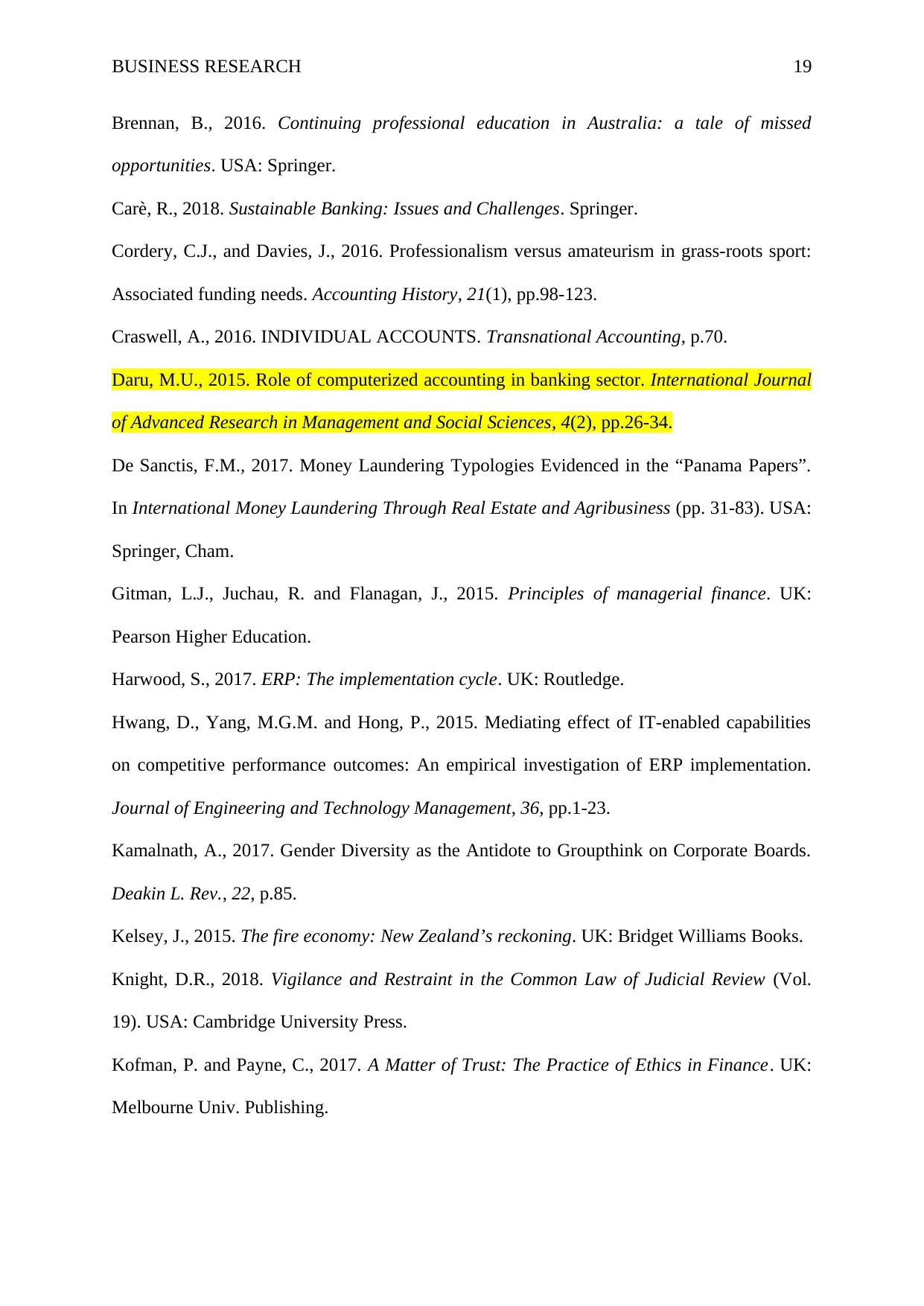
BUSINESS RESEARCH 19
Brennan, B., 2016. Continuing professional education in Australia: a tale of missed
opportunities. USA: Springer.
Carè, R., 2018. Sustainable Banking: Issues and Challenges. Springer.
Cordery, C.J., and Davies, J., 2016. Professionalism versus amateurism in grass-roots sport:
Associated funding needs. Accounting History, 21(1), pp.98-123.
Craswell, A., 2016. INDIVIDUAL ACCOUNTS. Transnational Accounting, p.70.
Daru, M.U., 2015. Role of computerized accounting in banking sector. International Journal
of Advanced Research in Management and Social Sciences, 4(2), pp.26-34.
De Sanctis, F.M., 2017. Money Laundering Typologies Evidenced in the “Panama Papers”.
In International Money Laundering Through Real Estate and Agribusiness (pp. 31-83). USA:
Springer, Cham.
Gitman, L.J., Juchau, R. and Flanagan, J., 2015. Principles of managerial finance. UK:
Pearson Higher Education.
Harwood, S., 2017. ERP: The implementation cycle. UK: Routledge.
Hwang, D., Yang, M.G.M. and Hong, P., 2015. Mediating effect of IT-enabled capabilities
on competitive performance outcomes: An empirical investigation of ERP implementation.
Journal of Engineering and Technology Management, 36, pp.1-23.
Kamalnath, A., 2017. Gender Diversity as the Antidote to Groupthink on Corporate Boards.
Deakin L. Rev., 22, p.85.
Kelsey, J., 2015. The fire economy: New Zealand’s reckoning. UK: Bridget Williams Books.
Knight, D.R., 2018. Vigilance and Restraint in the Common Law of Judicial Review (Vol.
19). USA: Cambridge University Press.
Kofman, P. and Payne, C., 2017. A Matter of Trust: The Practice of Ethics in Finance. UK:
Melbourne Univ. Publishing.
Brennan, B., 2016. Continuing professional education in Australia: a tale of missed
opportunities. USA: Springer.
Carè, R., 2018. Sustainable Banking: Issues and Challenges. Springer.
Cordery, C.J., and Davies, J., 2016. Professionalism versus amateurism in grass-roots sport:
Associated funding needs. Accounting History, 21(1), pp.98-123.
Craswell, A., 2016. INDIVIDUAL ACCOUNTS. Transnational Accounting, p.70.
Daru, M.U., 2015. Role of computerized accounting in banking sector. International Journal
of Advanced Research in Management and Social Sciences, 4(2), pp.26-34.
De Sanctis, F.M., 2017. Money Laundering Typologies Evidenced in the “Panama Papers”.
In International Money Laundering Through Real Estate and Agribusiness (pp. 31-83). USA:
Springer, Cham.
Gitman, L.J., Juchau, R. and Flanagan, J., 2015. Principles of managerial finance. UK:
Pearson Higher Education.
Harwood, S., 2017. ERP: The implementation cycle. UK: Routledge.
Hwang, D., Yang, M.G.M. and Hong, P., 2015. Mediating effect of IT-enabled capabilities
on competitive performance outcomes: An empirical investigation of ERP implementation.
Journal of Engineering and Technology Management, 36, pp.1-23.
Kamalnath, A., 2017. Gender Diversity as the Antidote to Groupthink on Corporate Boards.
Deakin L. Rev., 22, p.85.
Kelsey, J., 2015. The fire economy: New Zealand’s reckoning. UK: Bridget Williams Books.
Knight, D.R., 2018. Vigilance and Restraint in the Common Law of Judicial Review (Vol.
19). USA: Cambridge University Press.
Kofman, P. and Payne, C., 2017. A Matter of Trust: The Practice of Ethics in Finance. UK:
Melbourne Univ. Publishing.
Paraphrase This Document
Need a fresh take? Get an instant paraphrase of this document with our AI Paraphraser
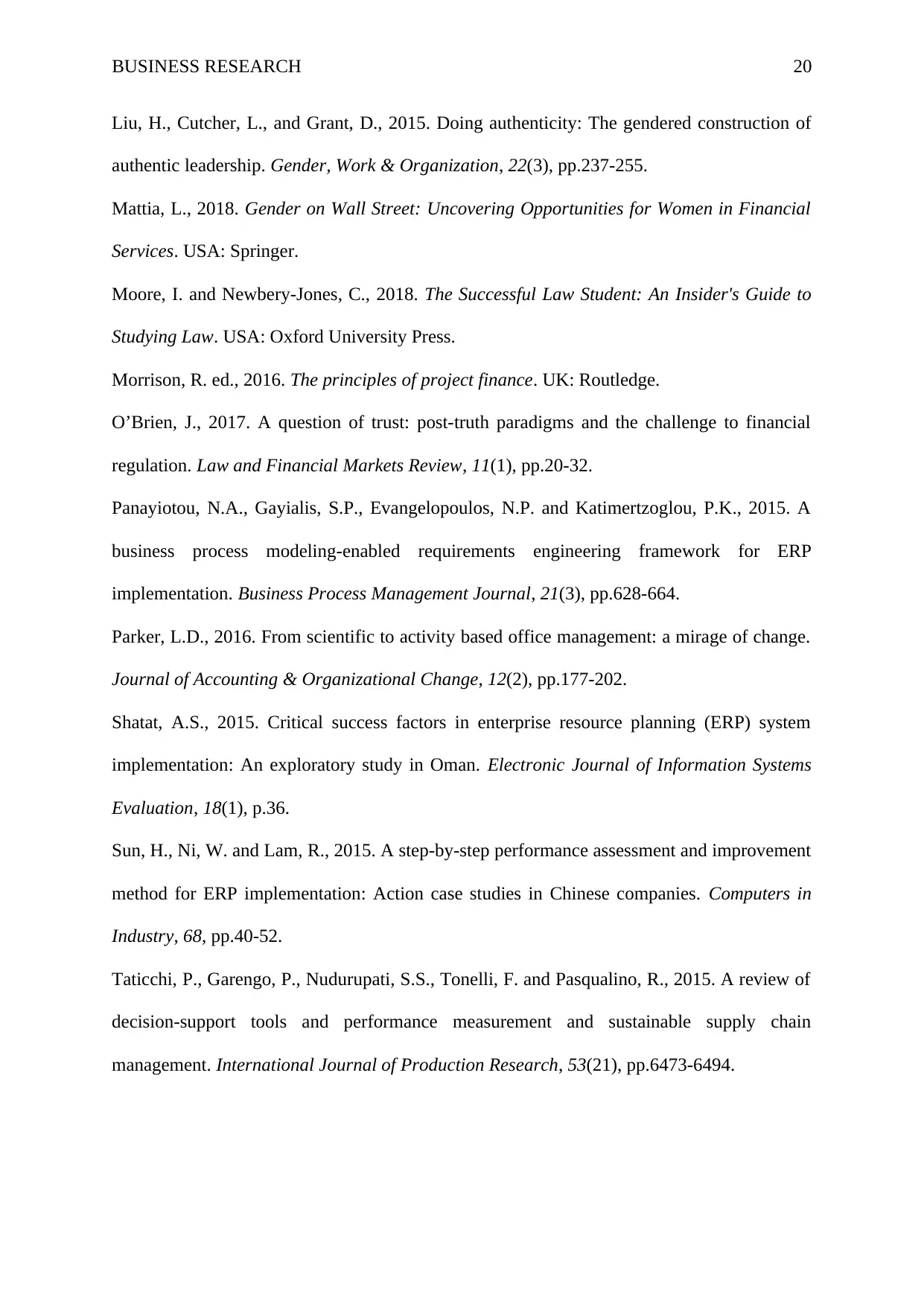
BUSINESS RESEARCH 20
Liu, H., Cutcher, L., and Grant, D., 2015. Doing authenticity: The gendered construction of
authentic leadership. Gender, Work & Organization, 22(3), pp.237-255.
Mattia, L., 2018. Gender on Wall Street: Uncovering Opportunities for Women in Financial
Services. USA: Springer.
Moore, I. and Newbery-Jones, C., 2018. The Successful Law Student: An Insider's Guide to
Studying Law. USA: Oxford University Press.
Morrison, R. ed., 2016. The principles of project finance. UK: Routledge.
O’Brien, J., 2017. A question of trust: post-truth paradigms and the challenge to financial
regulation. Law and Financial Markets Review, 11(1), pp.20-32.
Panayiotou, N.A., Gayialis, S.P., Evangelopoulos, N.P. and Katimertzoglou, P.K., 2015. A
business process modeling-enabled requirements engineering framework for ERP
implementation. Business Process Management Journal, 21(3), pp.628-664.
Parker, L.D., 2016. From scientific to activity based office management: a mirage of change.
Journal of Accounting & Organizational Change, 12(2), pp.177-202.
Shatat, A.S., 2015. Critical success factors in enterprise resource planning (ERP) system
implementation: An exploratory study in Oman. Electronic Journal of Information Systems
Evaluation, 18(1), p.36.
Sun, H., Ni, W. and Lam, R., 2015. A step-by-step performance assessment and improvement
method for ERP implementation: Action case studies in Chinese companies. Computers in
Industry, 68, pp.40-52.
Taticchi, P., Garengo, P., Nudurupati, S.S., Tonelli, F. and Pasqualino, R., 2015. A review of
decision-support tools and performance measurement and sustainable supply chain
management. International Journal of Production Research, 53(21), pp.6473-6494.
Liu, H., Cutcher, L., and Grant, D., 2015. Doing authenticity: The gendered construction of
authentic leadership. Gender, Work & Organization, 22(3), pp.237-255.
Mattia, L., 2018. Gender on Wall Street: Uncovering Opportunities for Women in Financial
Services. USA: Springer.
Moore, I. and Newbery-Jones, C., 2018. The Successful Law Student: An Insider's Guide to
Studying Law. USA: Oxford University Press.
Morrison, R. ed., 2016. The principles of project finance. UK: Routledge.
O’Brien, J., 2017. A question of trust: post-truth paradigms and the challenge to financial
regulation. Law and Financial Markets Review, 11(1), pp.20-32.
Panayiotou, N.A., Gayialis, S.P., Evangelopoulos, N.P. and Katimertzoglou, P.K., 2015. A
business process modeling-enabled requirements engineering framework for ERP
implementation. Business Process Management Journal, 21(3), pp.628-664.
Parker, L.D., 2016. From scientific to activity based office management: a mirage of change.
Journal of Accounting & Organizational Change, 12(2), pp.177-202.
Shatat, A.S., 2015. Critical success factors in enterprise resource planning (ERP) system
implementation: An exploratory study in Oman. Electronic Journal of Information Systems
Evaluation, 18(1), p.36.
Sun, H., Ni, W. and Lam, R., 2015. A step-by-step performance assessment and improvement
method for ERP implementation: Action case studies in Chinese companies. Computers in
Industry, 68, pp.40-52.
Taticchi, P., Garengo, P., Nudurupati, S.S., Tonelli, F. and Pasqualino, R., 2015. A review of
decision-support tools and performance measurement and sustainable supply chain
management. International Journal of Production Research, 53(21), pp.6473-6494.
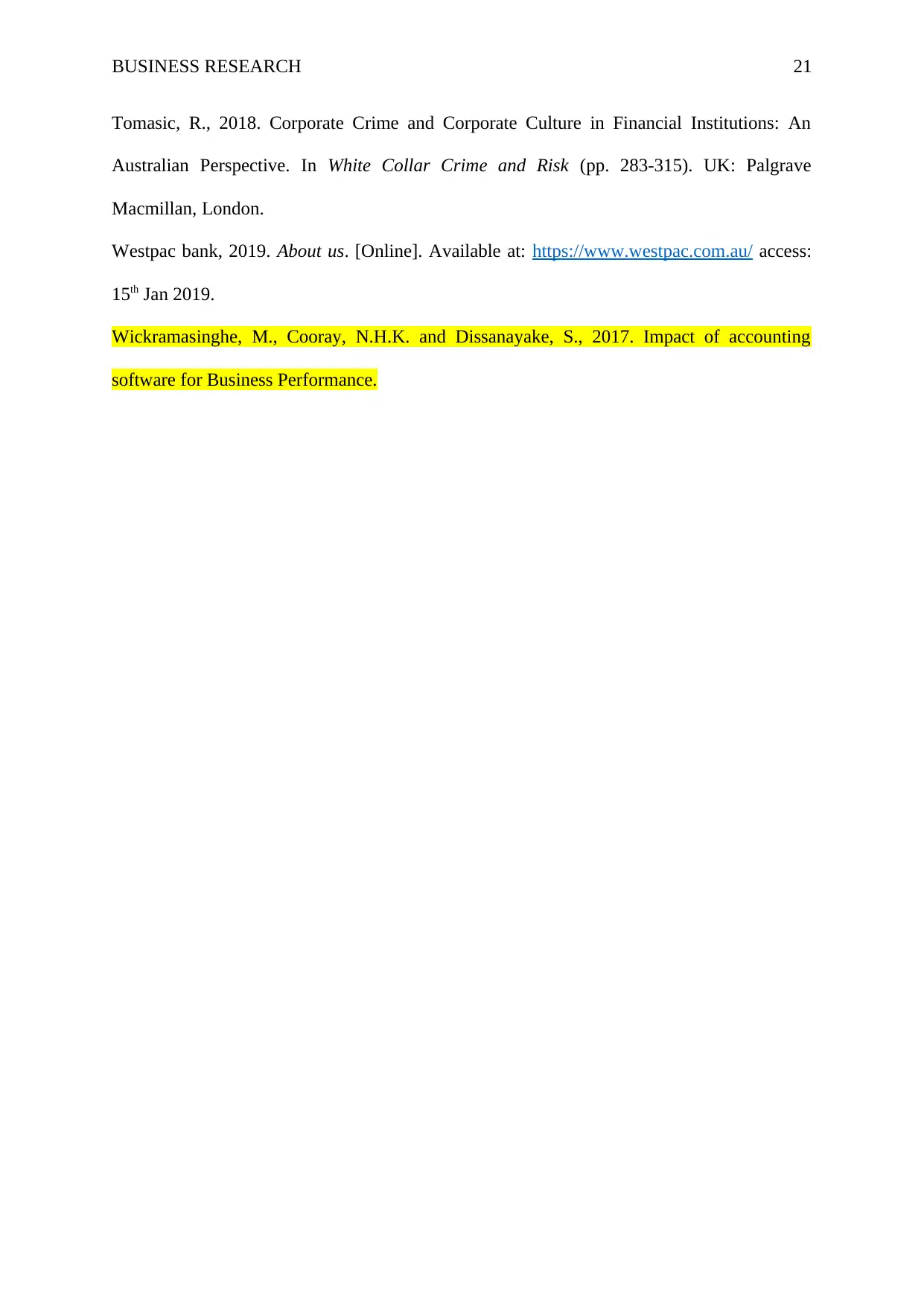
BUSINESS RESEARCH 21
Tomasic, R., 2018. Corporate Crime and Corporate Culture in Financial Institutions: An
Australian Perspective. In White Collar Crime and Risk (pp. 283-315). UK: Palgrave
Macmillan, London.
Westpac bank, 2019. About us. [Online]. Available at: https://www.westpac.com.au/ access:
15th Jan 2019.
Wickramasinghe, M., Cooray, N.H.K. and Dissanayake, S., 2017. Impact of accounting
software for Business Performance.
Tomasic, R., 2018. Corporate Crime and Corporate Culture in Financial Institutions: An
Australian Perspective. In White Collar Crime and Risk (pp. 283-315). UK: Palgrave
Macmillan, London.
Westpac bank, 2019. About us. [Online]. Available at: https://www.westpac.com.au/ access:
15th Jan 2019.
Wickramasinghe, M., Cooray, N.H.K. and Dissanayake, S., 2017. Impact of accounting
software for Business Performance.
1 out of 21
Related Documents
Your All-in-One AI-Powered Toolkit for Academic Success.
+13062052269
info@desklib.com
Available 24*7 on WhatsApp / Email
![[object Object]](/_next/static/media/star-bottom.7253800d.svg)
Unlock your academic potential
© 2024 | Zucol Services PVT LTD | All rights reserved.





